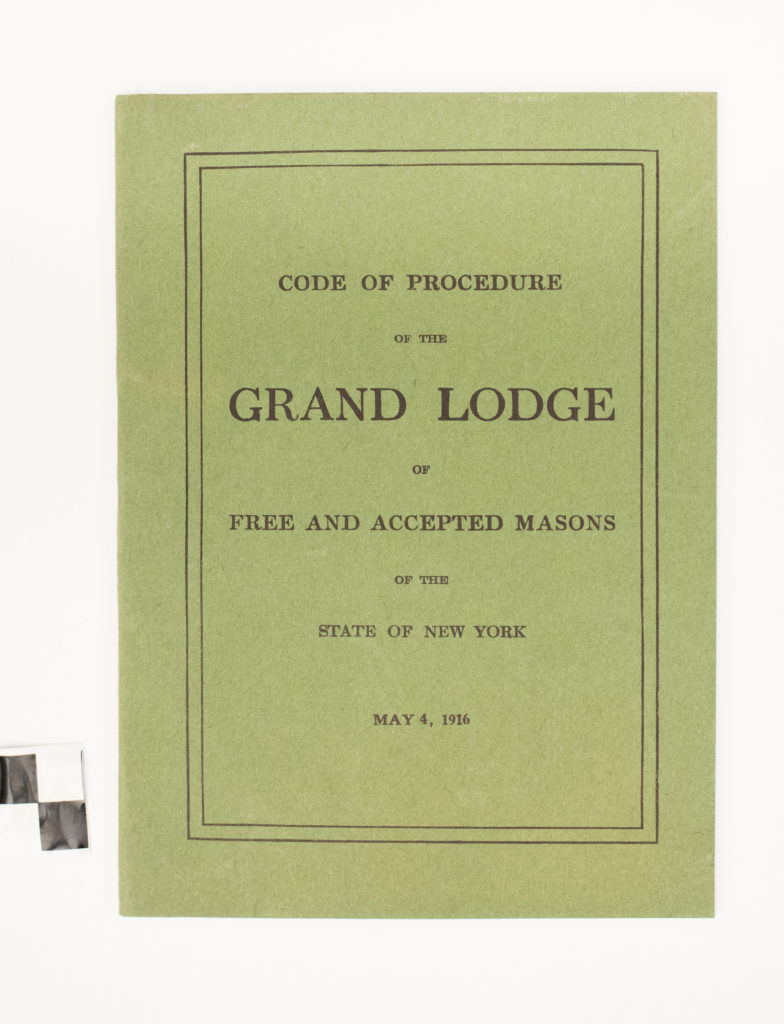By Alexander Vastola
Director, The Chancellor Robert R. Livingston Masonic Library of Grand Lodge
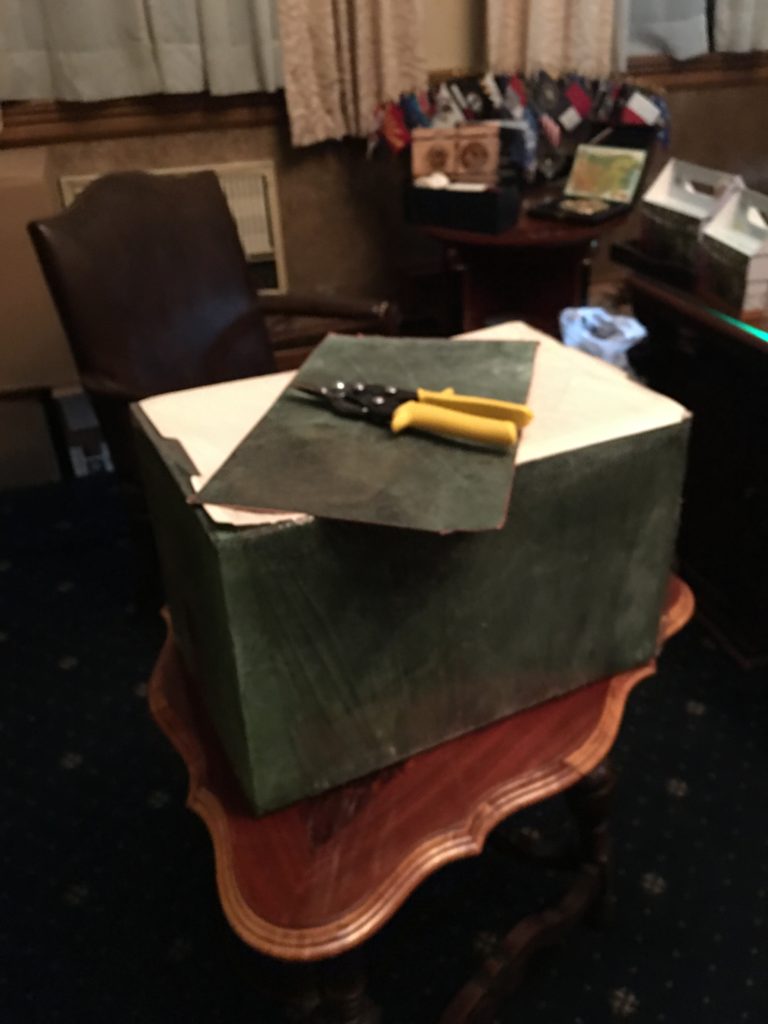
During the Special Communication of Freemasons at the Utica campus on October 5th, 2019, I was honored when M.’.W.’. William Sardone, Grand Master of the Grand Lodge of Free & Accepted Masons of the State of New York, invited me to come to the Communication to open a time capsule with him. This time capsule was from the cornerstone of the Soldiers and Sailors Memorial Hospital, located on the campus of the Masonic Home in Utica, N.Y., which was sealed in the cornerstone on September 20, 1919. M.’.W.’. Sardone had to use metal cutting pliers, visible on the top of the box in the above image, showing the time capsule after it was transported to The Chancellor Robert R. Livingston Masonic Library of Grand Lodge in New York City.

The inside of the time capsule box 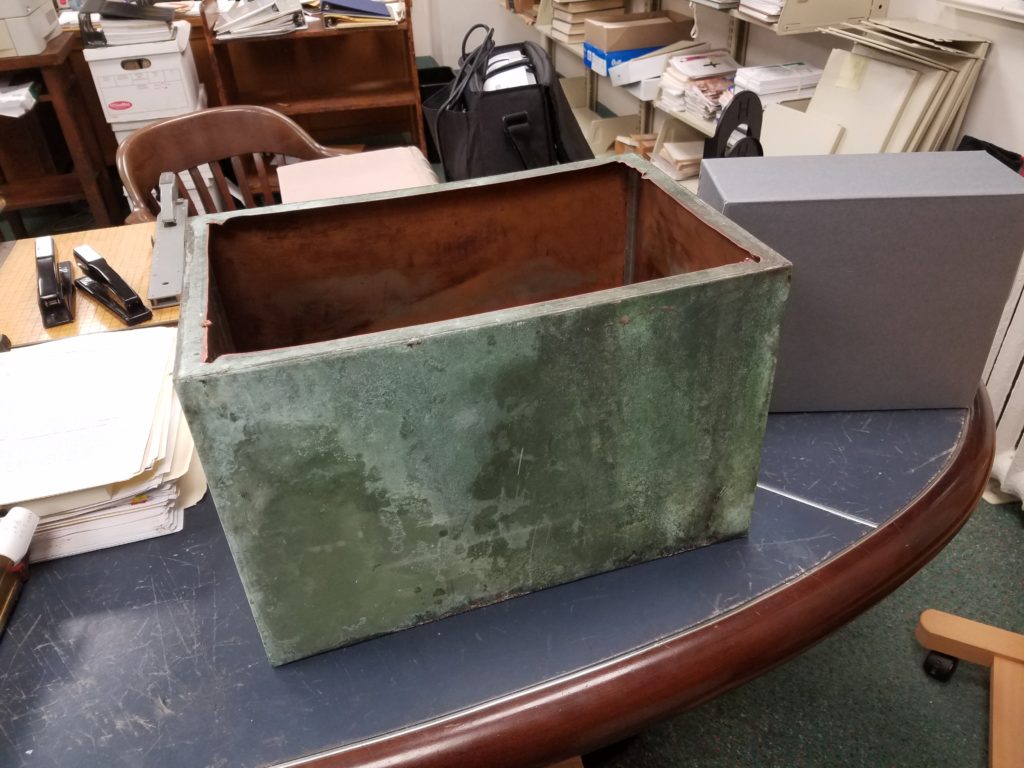
The time capsule box at the Library
The box was made of copper plating, as shown in the above images, and was welded shut, which resulted in the items inside being in remarkably good condition even one hundred years after the time capsule was sealed shut.
The Context of the Time Capsule:
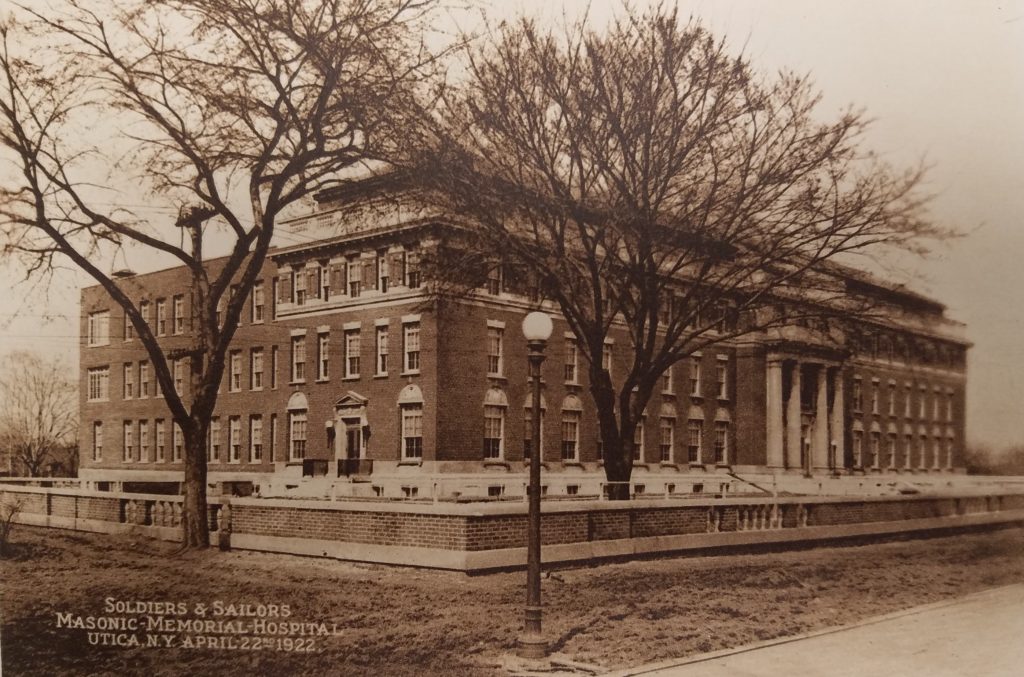
The origins of this time capsule date back to September of 1919, as World War I has ended, and the Masonic Home Campus in Utica, N.Y., was beginning to grow under the leadership of Superintendent William J. Wiley, 27 years after the Masonic “Asylum” was first established in 1893 as a home for worthy indigent Masons, their widows, and orphans. With Masonic veterans returning from the war in need of medical care, it was clear that a new hospital building on the campus was needed. At the end of World War I, there was a fund consisting of $700,000.00, which had been raised to assist servicemen during the war. The Masonic Home decided to use this money to help construct The Soldiers and Sailors Memorial Hospital on the Masonic Home campus in Utica, N.Y. In May of 1919, MW William S. Farmer, Grand Master of the Grand Lodge of the State of New York had stated the following:
“For years there has been a crying need for a hospital. At present the trustees are compelled to reject many an application for admission to the home, for the reason that the subject of the application is suffering from disease, either chronic or acute, and therefore not admissible. The result of this is that the very patient most in need of our benefaction is turned down and in many instances compelled to spend the period of his incapacity either in an alms house or become the subject of some private charity.”
He also stated that the hospital would serve as both a memorial to the Masons from New York who died during the Great War, and as a place where Masonic Veterans from the War could come to get “medical care free of all expense.”
The Laying of the Corner Stone: September 20, 1919:

After the Masonic Home decided to erect a new hospital building on the Utica campus, the cornerstone that enclosed the time capsule was laid on September 20th, 1919. It was reported in the September 20, 1919 issue of the Utica Saturday Globe that thousands of Masons marched in a parade from Genesee Street in Utica to the campus of the Masonic Home, where the corner stone ceremony took place.
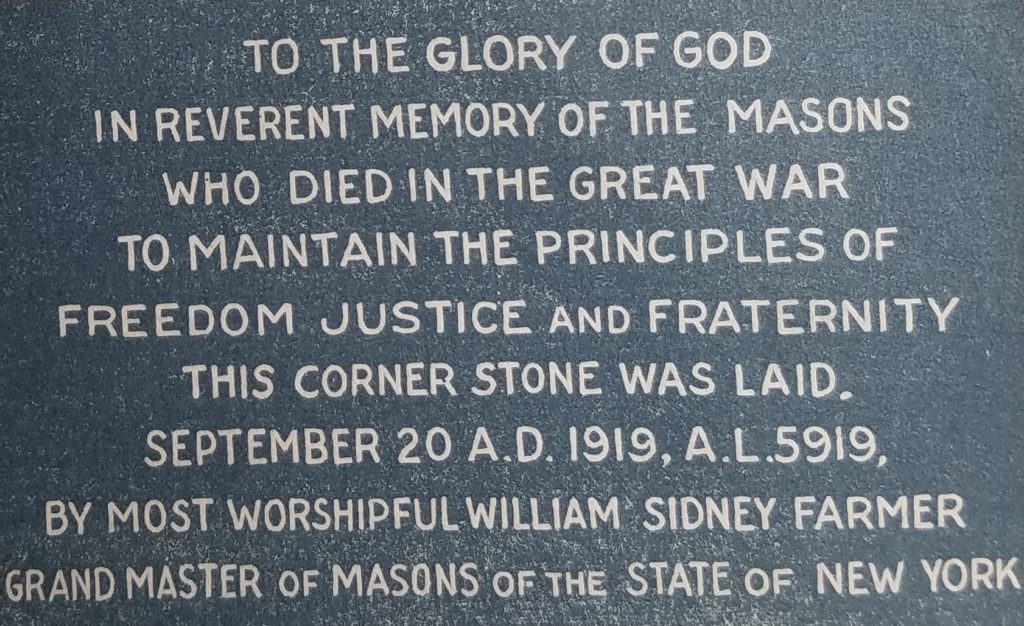

What was Inside the Time Capsule?
So what treasures did our library and museum staff and myself find within this time capsule?
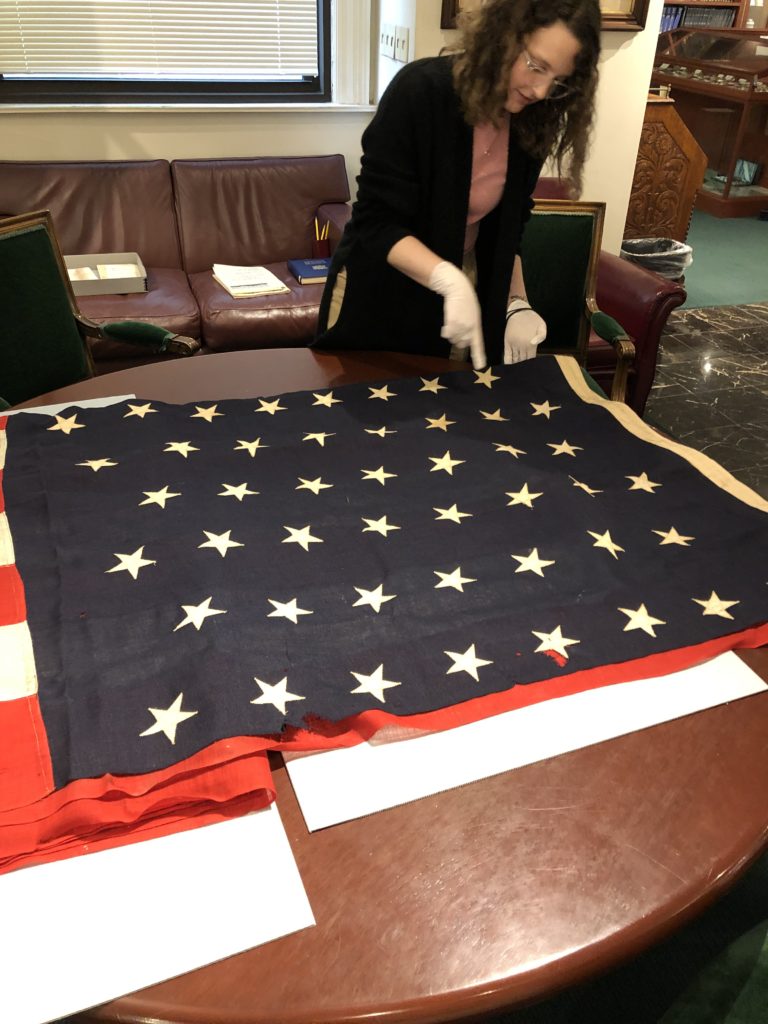
Christine Hesch, Curator of The Chancellor Robert R. Livingston Masonic Library of Grand Lodge, counts the stars on the large American flag after it was unfolded 
The smaller flags of the Allied Nations
The Flags
The first item removed from the time capsule was a large American Flag. This flag was at least 6.5 feet tall, and was hand-made: I noticed that every stripe and star in the flag was stitched together by hand. The flag had 46 stars, dating it to the period when Oklahoma was admitted as a State to the Union on November 16, 1907, and was the official U.S. flag for four years under U.S. President Theodore Roosevelt and William Howard Taft until 1912, when New Mexico and Arizona became U.S States. My theory for why this flag was included was that it may have flown from one of the flag poles at the Utica campus, and rather than retiring the flag, they folded it and placed it in the time capsule. In addition to the large flag, there were six smaller flags rolled up in an issue of The Masonic Standard from 1919: the flags were: American, British, Union Jack, French, Italian, and Belgian, one for each of the Allied Nations during World War I. The Treaty of Versailles, which ended World War I, was signed in 1919, so these flags may have been included to commemorate this.
The Typed Inventory of Items:
Under these flags was a typed Inventory of the items included in the time capsule, typed on good-quality paper stationary from the Masonic Home in Utica, N.Y.
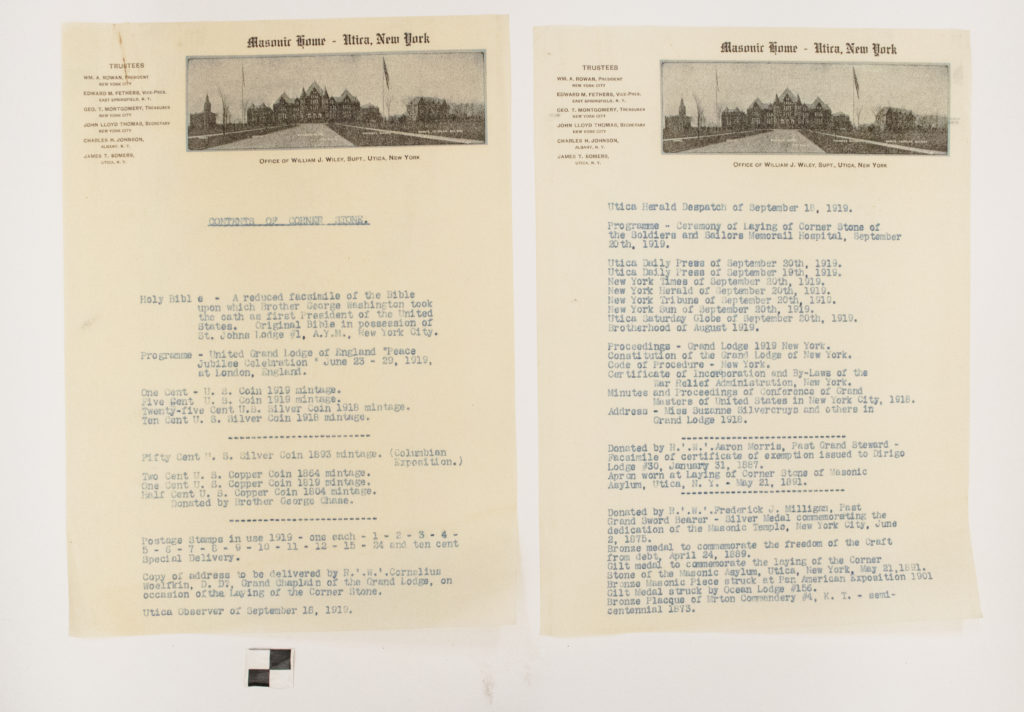
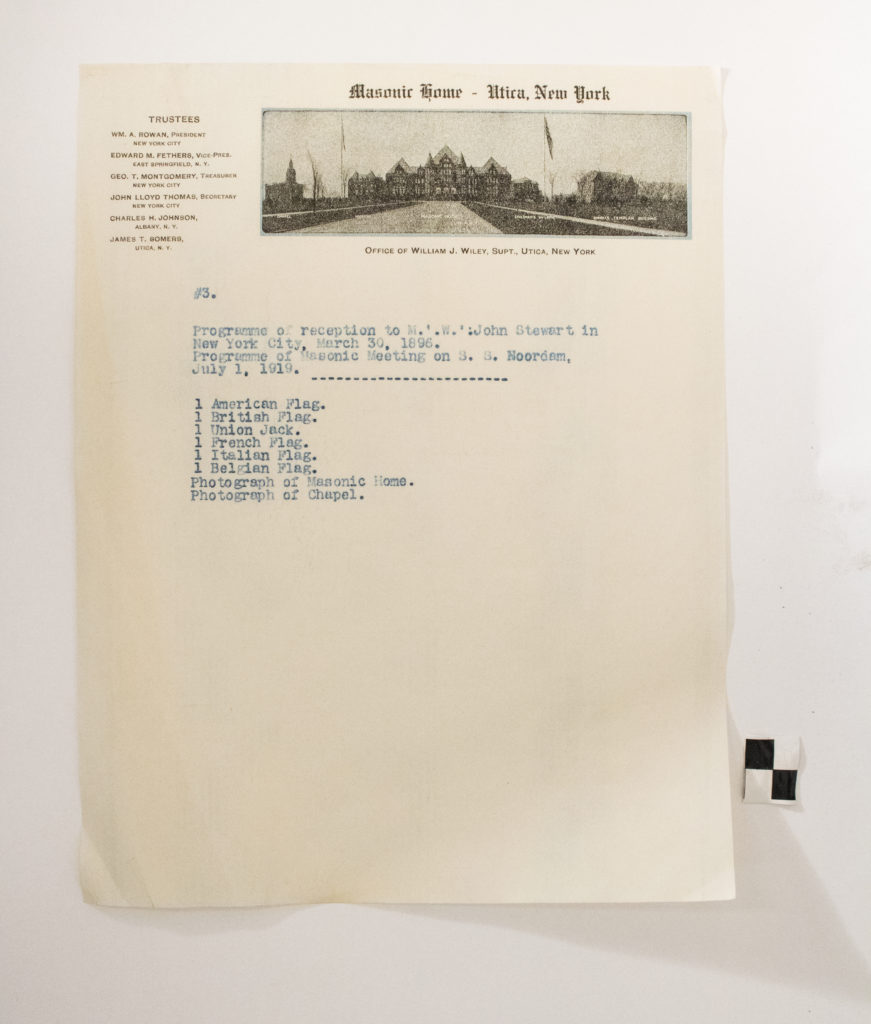
The Photographs:
There were several photographs in the time capsule, such as one that was mentioned in the Inventory, of the Masonic Home campus in Utica, N.Y., showing the Old Administration Building in the center, and the Tompkins Memorial Chapel on the left. However, the photographs included in the time capsule of people were not listed in the Inventory, suggesting that they may have been placed in the time capsule on the day the corner stone was laid and the time capsule sealed – eight photographs in all.
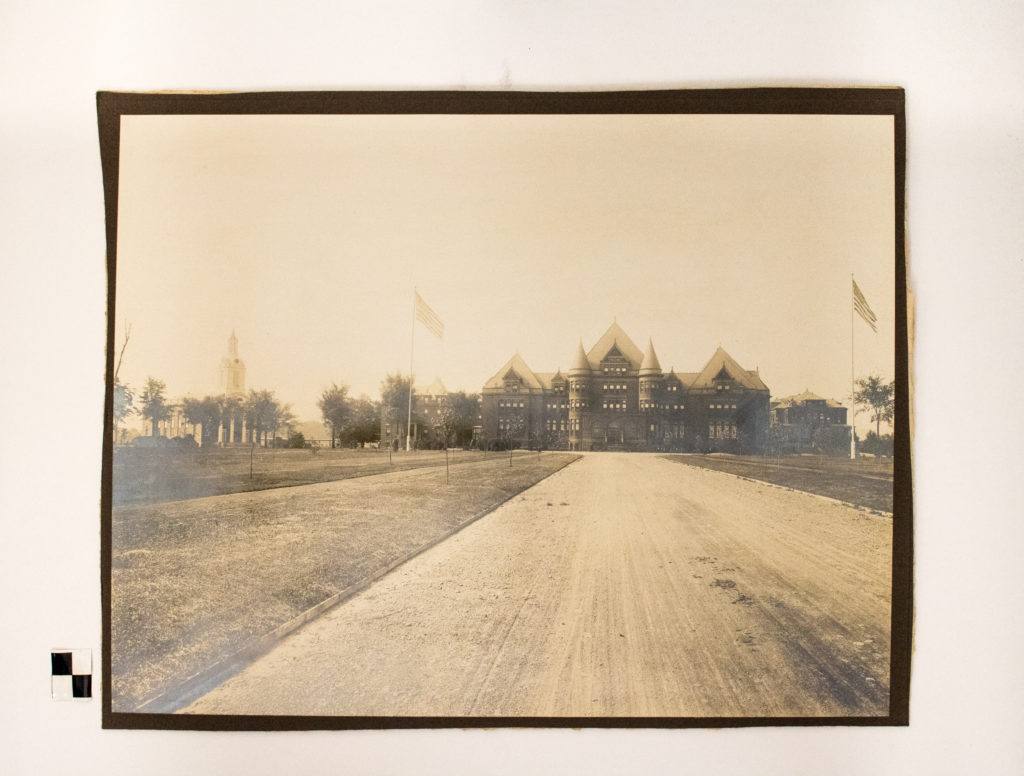
One of these photographs was of Freemason Charles H. Johnson, or “Charlie.” He was a Freemason member of Ancient City Lodge No. 542 in Albany, N.Y. He also served as Grand Master from 1930-1932 and Grand Secretary from 1932-1947. He lived in Albany and was a retired minister, working primarily on social welfare, superintending institutions for children and he wrote articles and gave lectures on children, the mentally ill, and the incarcerated. In 1914, he was appointed as Deputy Warden of Sing Sing prison, and served as NYS Commissioner of Social Welfare from 1916-1932. The Memorial Hospital was significant to him since he lost his only son, Orville, who was killed in action on July 18, 1918 at Chateau-Thierry in World War I as a Second Lieutenant of the 112th Machine Gun Battalion of the 26th Division.
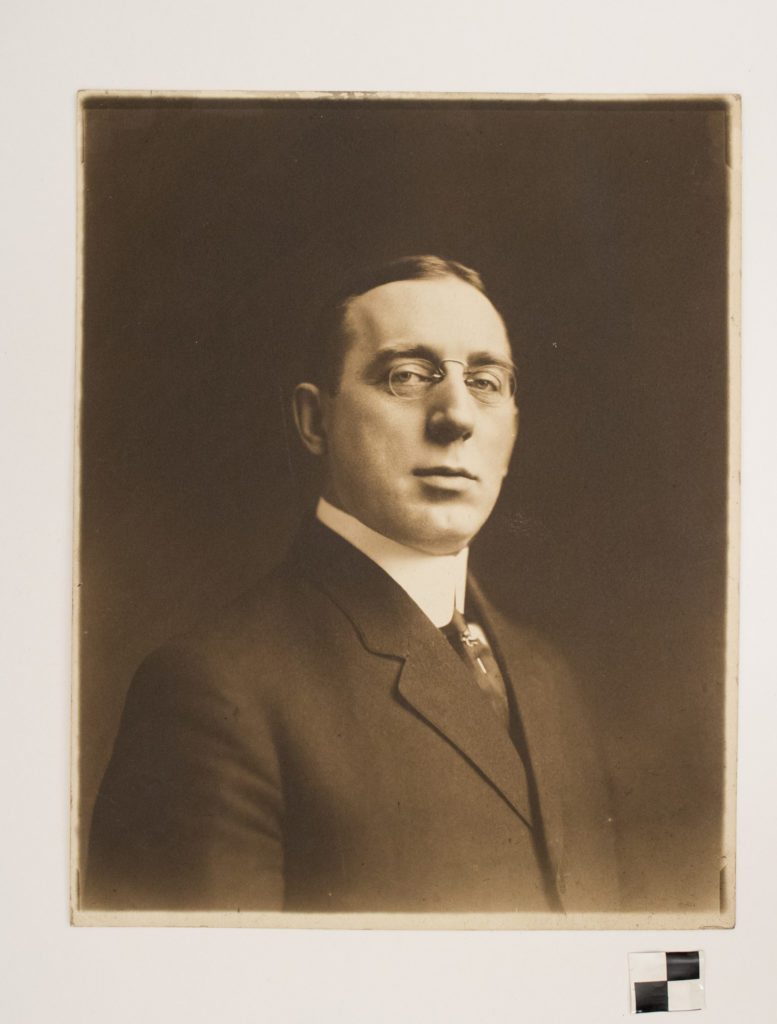
The second photograph discovered was of Freemason John Stewart. John Stewart was a member of Albion Lodge No. 26 (now called St. John’s Lodge No. 1). He served as a Trustee of the Masonic Hall & Asylum Fund and was Treasurer of the Board of Trustees during the building of the Masonic Home in Utica, N.Y. He also served as the Deputy Grand Master of the State of New York from 1894-1895, and was elected Grand Master in 1896 (hence the date on the photograph). In 1906, he again served as Trustee of the Masonic Hall & Asylum Fund and its Treasurer, and when he died in 1908, he was on the Committee charge of building the present Grand Lodge Building at 71 West 23rd Street.
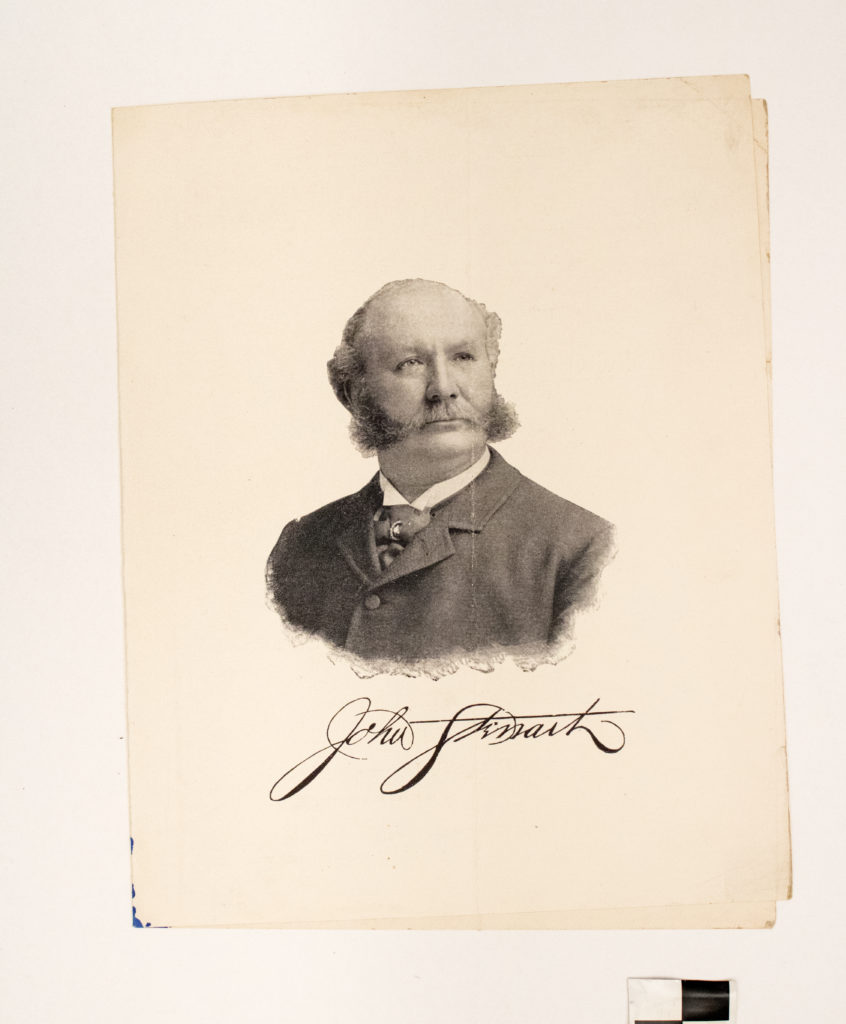
The third photograph that was found was of Freemason George T. Montgomery. He served as District Deputy Grand Master from 1903-1904. He also served as a trustee of the Masonic Hall & Asylum in 1907 and 1909-1918/19. In addition,when the corner stone was laid in 1919, he was serving as the Treasurer of the Masonic Home in Utica, N.Y.
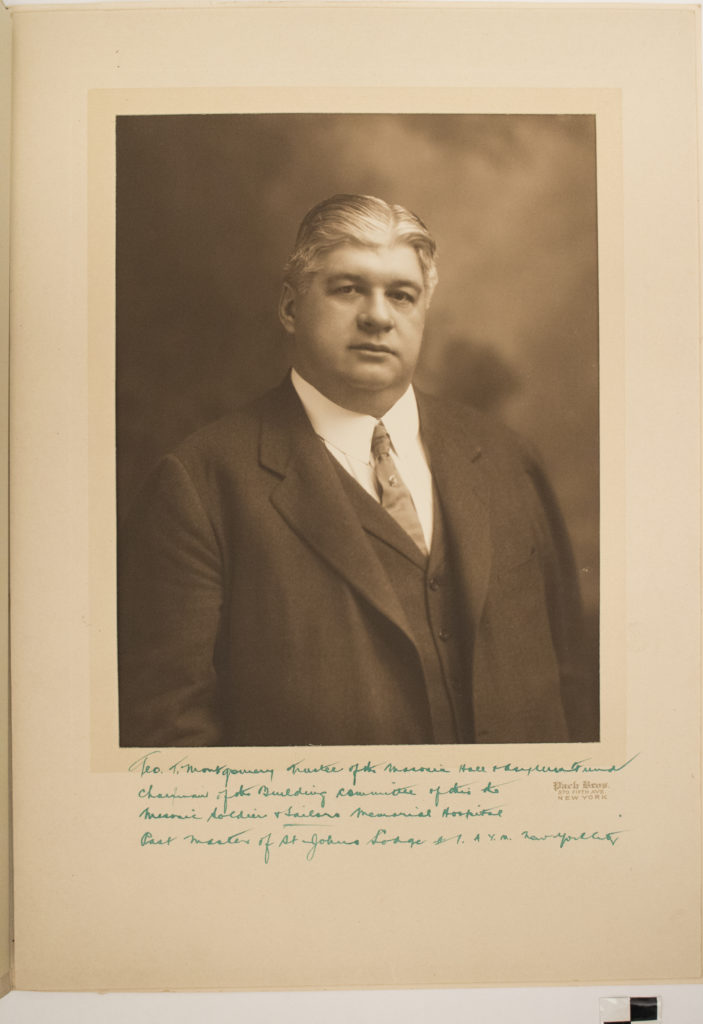
The fourth photograph observed was of Freemason William S. Farmer. He was a member of Central City Lodge No. 305 in Syracuse, New York. In 1889, he was the vice president and managing Director of Farmers and Traders Bank, and worked as a lawyer with the firm Kimball in South Dakota. In 1915, he moved to Syracuse to practice law with the firm W. S. and H. H. Farmer and was appointed a Judge of the Municipal Court, a position he served in until his death. Furthermore, he was also the Chairman of the New York Committee on the George Washington Memorial – where he did fundraising for this monument and worked hard to establish it in Alexandria, Virginia.
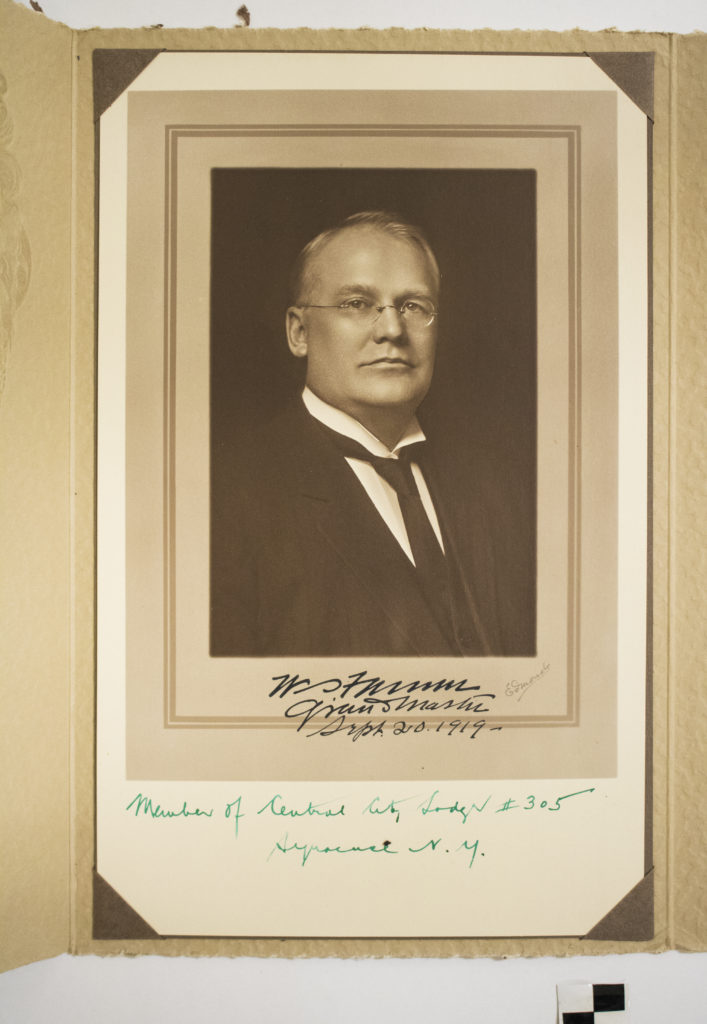
The fifth photograph examined from the box was of Freemason Robert H. Robinson. He was a retired wholesale drapery merchant for the Mills & Gibbs Corporation of 2 Park Avenue, and lived at 170 West 73rd Street, N.Y.C. He was also a noted orator, serving as Treasurer of the general Synod of the Reformed Church of America, speaking on the significance of the Bible and other subjects. He was a 33rd degree Mason and member of Crescent Lodge No. 402, and from 1914-1916, he served as Grand Marshal of the Grand Lodge of the State of New York; also serving as Deputy Grand Master from May 1918-May 1920, and finally as Grand Master from May 1920-May 1922. In addition, he served on many Masonic Committees, including the Grand Lodge Committee on the Hall & Asylum in 1916, the Masonic Home in Utica, and the War Relief Committee in 1918.

The sixth photograph was of Freemason S. (Samuel) Nelson Sawyer. A lifelong resident of Palmyra, New York, he was a 33rd degree Mason who was a member of Palmyra Lodge 248 in Palmyra, New York, and served as Grand Master of the Grand Lodge of the State of New York from 1908-1910. In his professional life, he served as a NY Supreme Court Justice from October 1908-December 31, 1929. In addition, he was supposedly the one who first suggested the idea of the Chapel at the Utica Masonic Home campus (the previous chapel was in a small room in the Old Administration Building), which led to Superintendent Wiley and the grand master discussing the chapel, and the new chapel was built (in April of 1910, he laid the cornerstone of this building). He also had much Committee involvement, as he was a nearly twenty year member of the Committee of the Hall & Asylum, the War Relief Commission, and the Committee that erected the Soldiers’ & Sailors’ Memorial Hospital in Utica. It also makes that that he would have been involved with this time capsule to preserve these artifacts, as he was a longtime member of the New-York Historical Society.

The seventh photograph included in the time capsule was of Freemason and Superintendent William J. Wiley. He was the first superintendent of the Masonic Home who served for a lengthy period – due to his care of the children at the home – he was nicknamed “Dad” Wiley, and worked at the home from 7 in the morning to 9 at night, seven days a week.He served as superintendent for nearly 40 years: from 1906 to 1945, and was a 33rd degree Mason, and a member of Copestone Lodge No. 641 in N.Y.C.In addition,on May 7, 1936, he was elected Past Grand Master of the NY Grand Lodge, and previously in 1930, he was voted the “outstanding citizen of Utica.”Superintendent Wiley was also the one who discontinued the education of orphan on the Utica campus, instead working to have them educated in the Utica Public Schools.Furthermore, superintendent Wiley was also a builder for the campus, as during his tenure, the following building were constructed:The Charles Smith Infirmary, 1907;The Daniel D. Tompkins Memorial Chapel, 1911;The Knights Templar Building, 1917; The Scottish Rite Building, 1922;the 1923 “Cottage”; The John W. Vrooman Memorial Dormitories, 1928, and Wiley Hall, 1928.
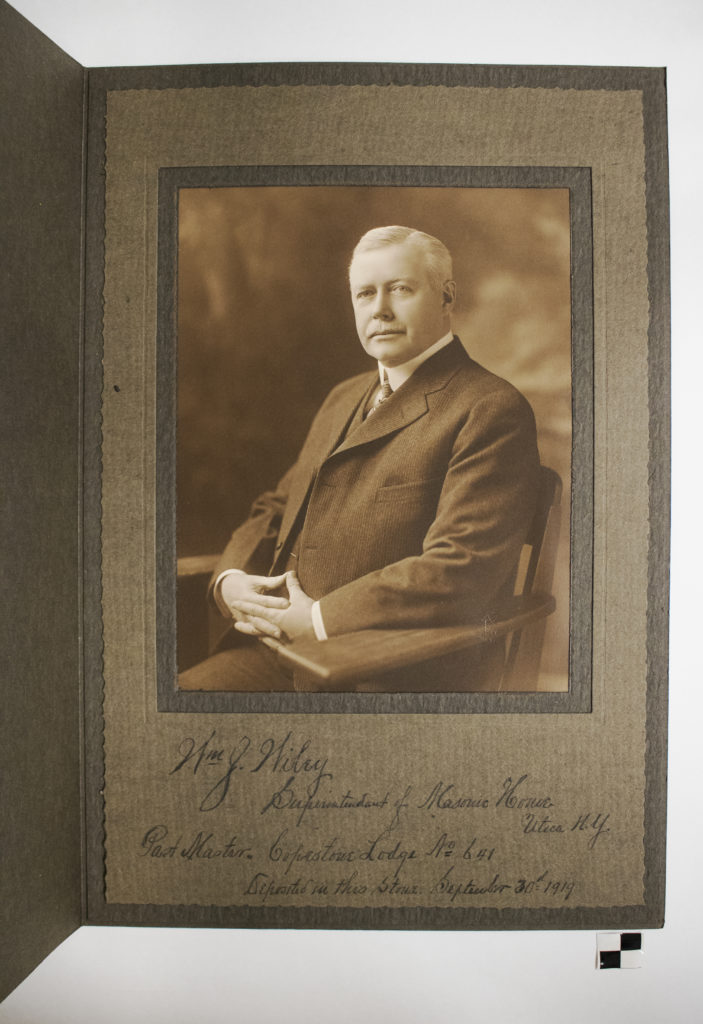
Finally, the eighth photograph was of Mrs. Veturia I. Wiley with her daughter, Miss Veturia I. Wiley. The Masonic Standard of 1911 called Mr. Wiley and his wife and daughter “Santa Claus And His Assistants” due to their service to the children of the Masonic Home. The mother, Mrs. Veturia I. Wiley, was Superintendent Wiley’s wife and Matron of the Masonic Home in Utica, New York, called “Mamma Wiley” by the children. Mrs. Wiley obituaries stated that she was well-loved by the children, always ready to address their needs. Her daughter, Miss Veturia I. Wiley, was the organist for the Masonic Home in the Daniel D. Tompkins Memorial Chapel.
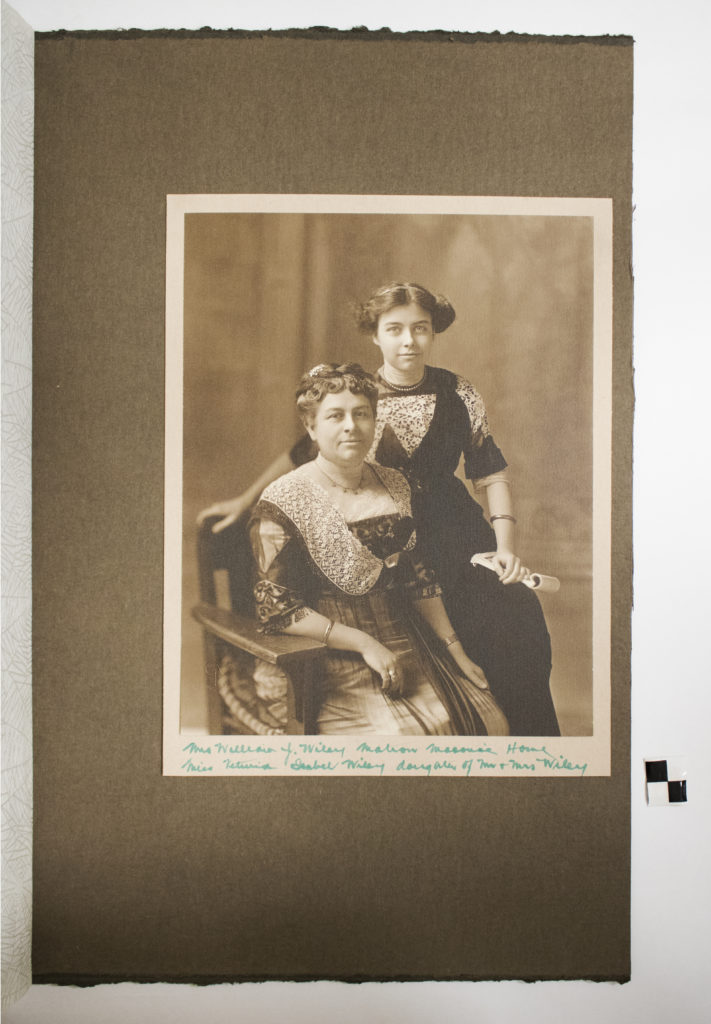
Newspapers with Inventory:
In addition to photographs, there were also several 1919-era newspapers included in the time capsule, which recorded the current local and nationwide events of the time. Here is an example of one of these newspapers, The Utica Saturday Globe, which mentioned the corner stone laying event of the Soldiers & Sailors Memorial Hospital. The biggest event mentioned in all the newspaper was the 1919 Steelworkers’ Strike. There was also a written list of the newspapers that were placed in the time capsule.
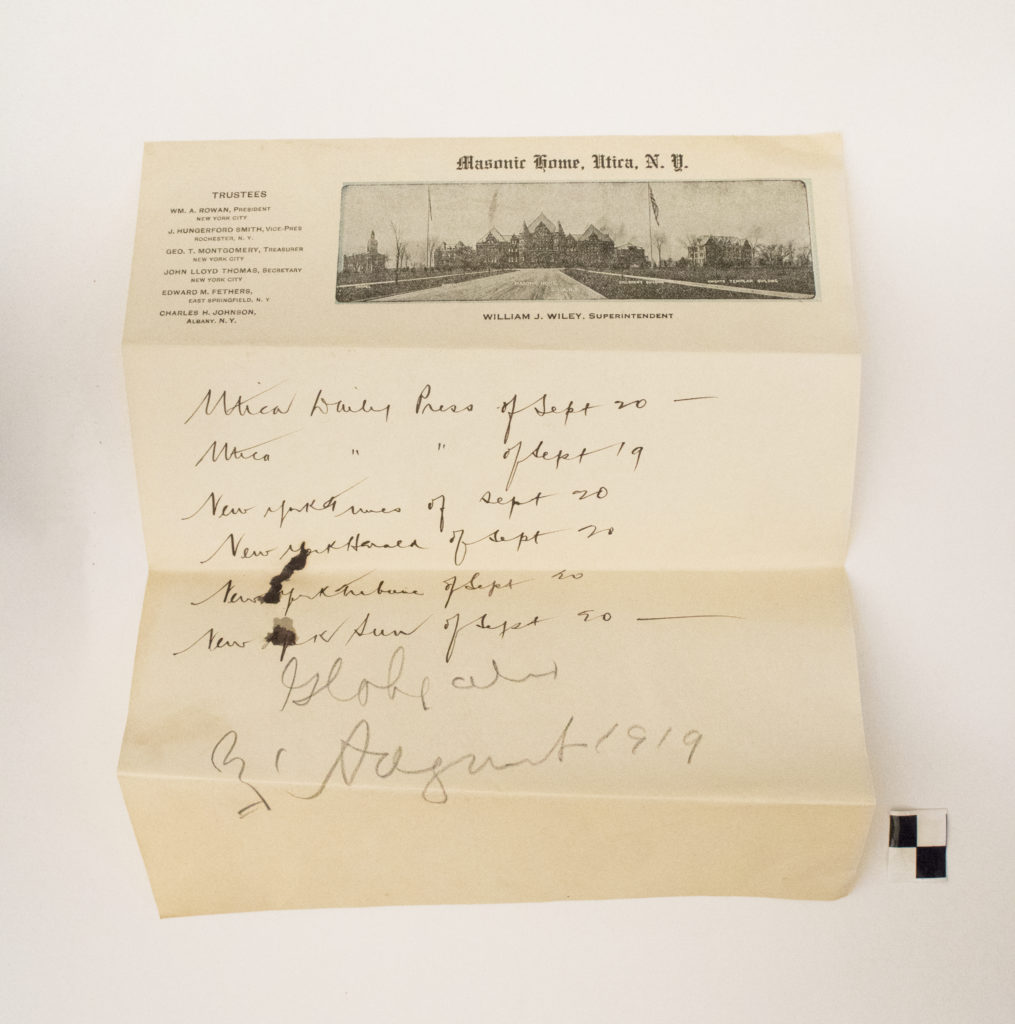
The Newspaper Inventory 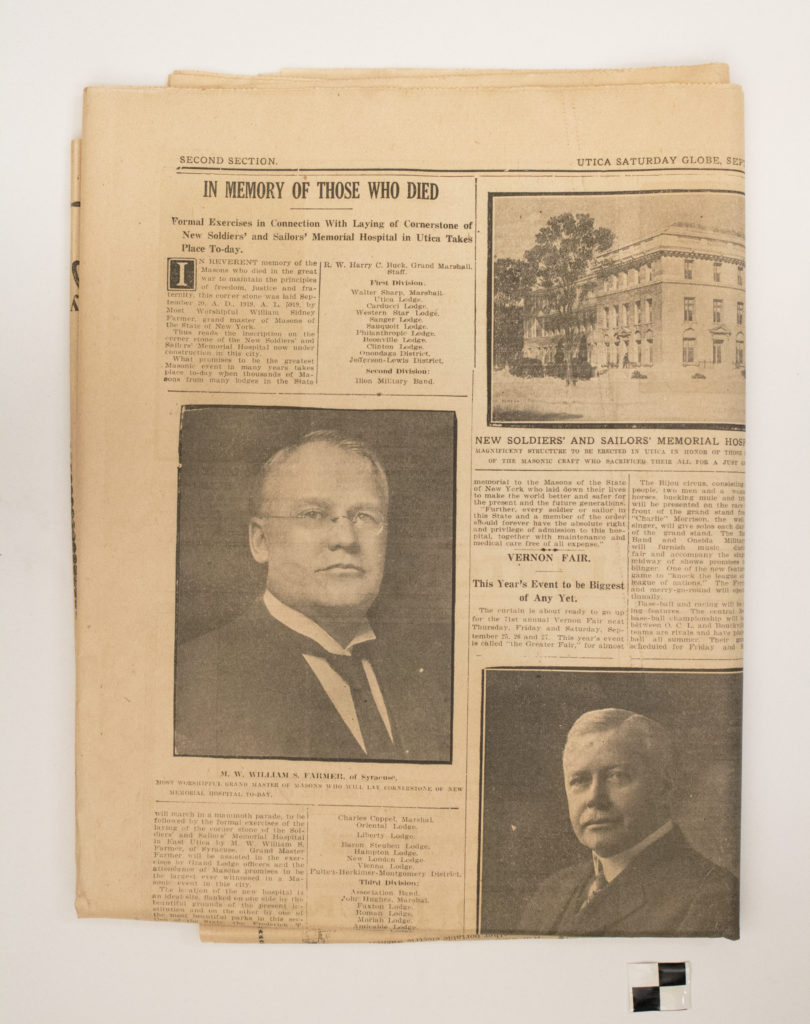
The Utica Saturday Globe newspaper, which reported the cornerstone laying ceremony of the Soldiers & Sailors Memorial Hospital
Books:
The time capsule also had several Masonic publications as well. One example was a small facsimile, or reproduction, contained in a green box, of the St. John’s Bible, upon which Freemason George Washington took the oath of office as the first President of the United States.
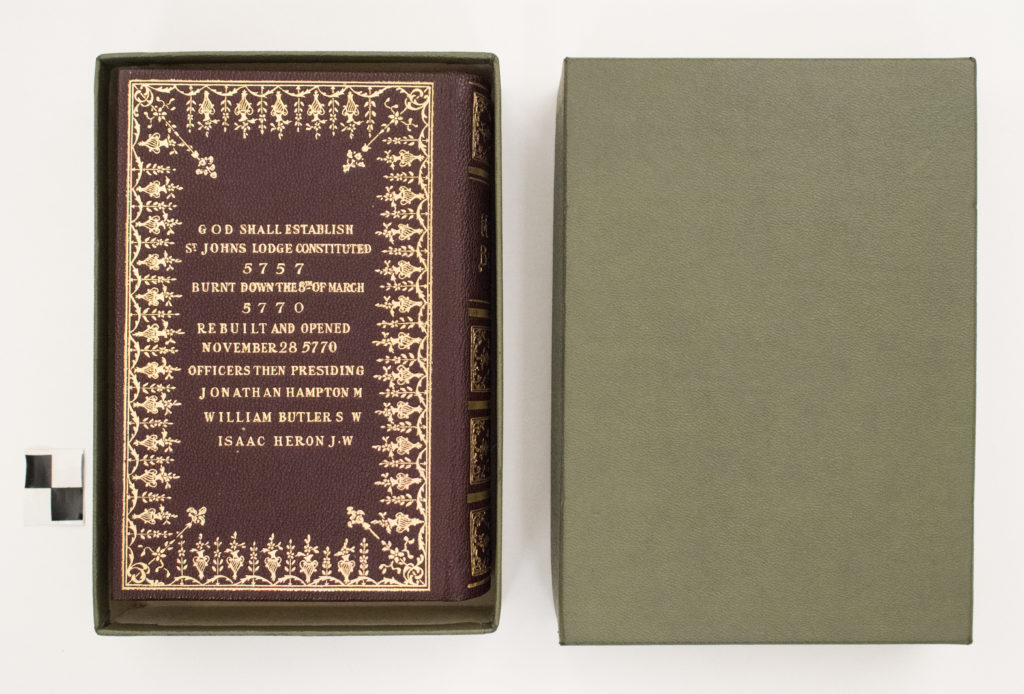
There are also copies of the Constitution, Regulations, Definitions, and Rules of order of the New York Grand Lodge and the Code of Procedure of the New York Grand Lodge from the time period the time capsule was sealed.
There was also a 1918 Grand Lodge pamphlet book from Miss Suzanne Silvercruys and others that was in an envelope from the Office of the Grand Secretary. In this book, Miss Silvercruys thanks MW Thomas Penny for the Grand Lodge of the State of New York sending $5,000.00 to Belgian Relief to help Belgium recover from the devastation caused by World War I.
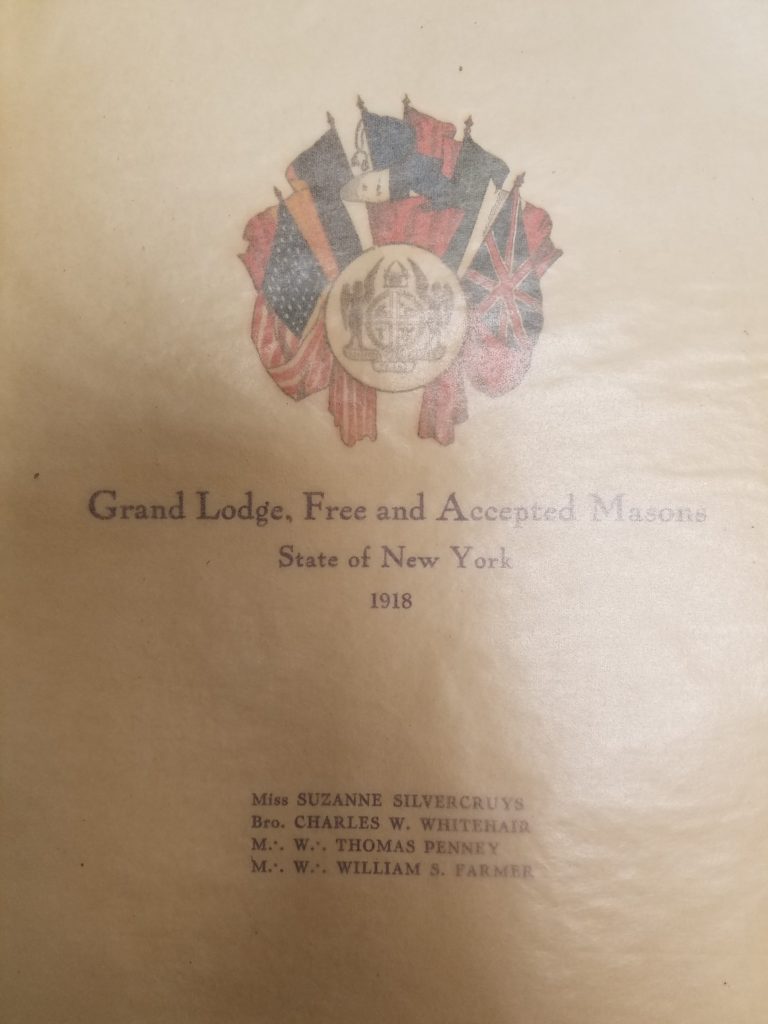
In addition, there were other Masonic publications as well. For instance, there was a copy of the 1919 Proceedings of the Grand Lodge of New York, the Minutes and Proceedings of the Conference of Grand Masters of the United States in New York City from 1918 (note the flag of the Allied Nations to the left of the title page).
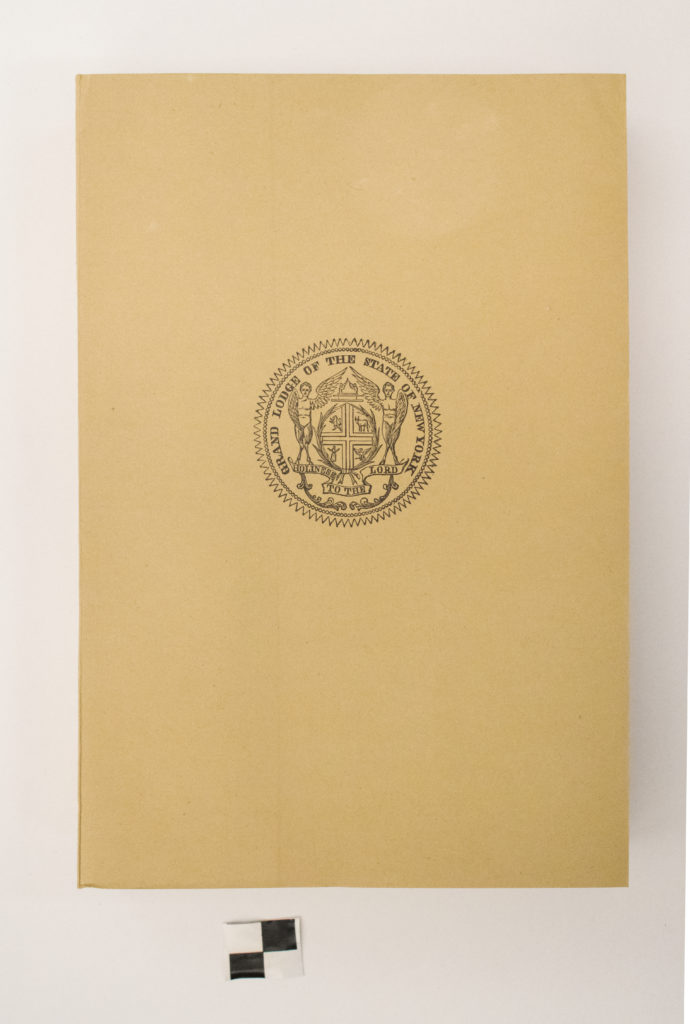
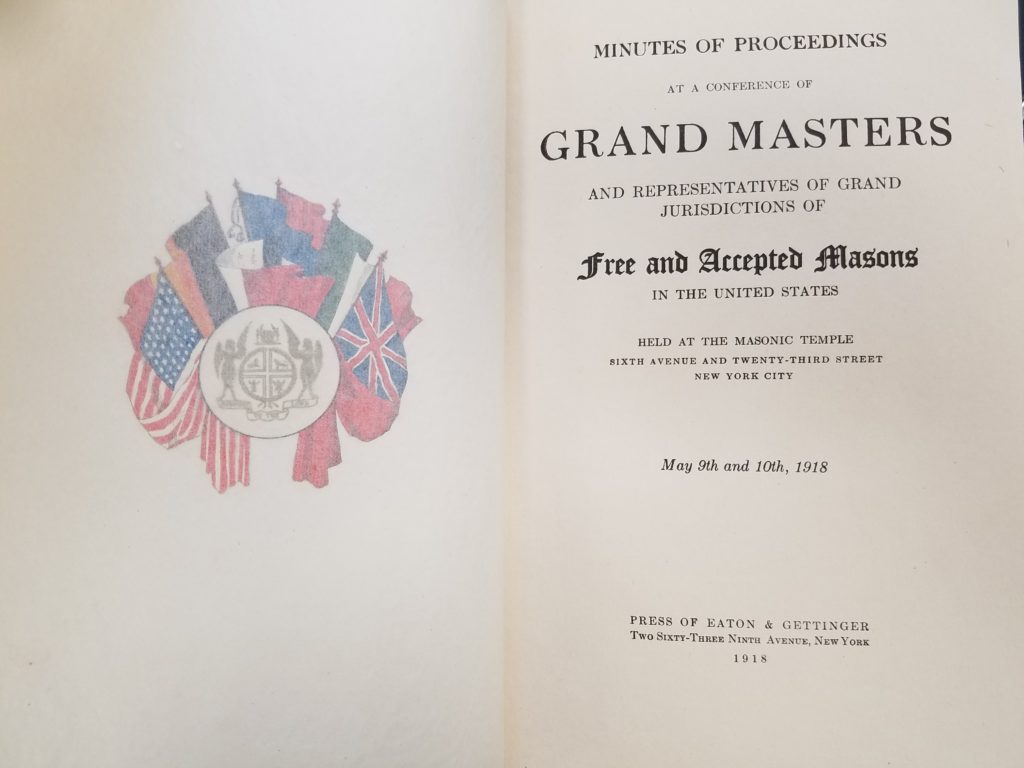
There was also a copy of the Certificate of Incorporation and By-Laws of the War Relief Administration. The War Relief Administration (or WRA) was set up by the New York Grand Lodge after America’s entry into World War I by 1917 and the Grand Lodge found that 50,000 New York State Masons were serving in various branches of the services, many overseas. The WRA made arrangements with other American Grand Lodges to set up relief work in France, headed by MW Townsend Scudder – who raised funds and selected personnel. However, the conditions at the front combined with a lack of transportation for men and goods made it hard for the WRA to progress far with its plans before the Armistice. It was the money left over from the WRA that helped to fund the hospital.
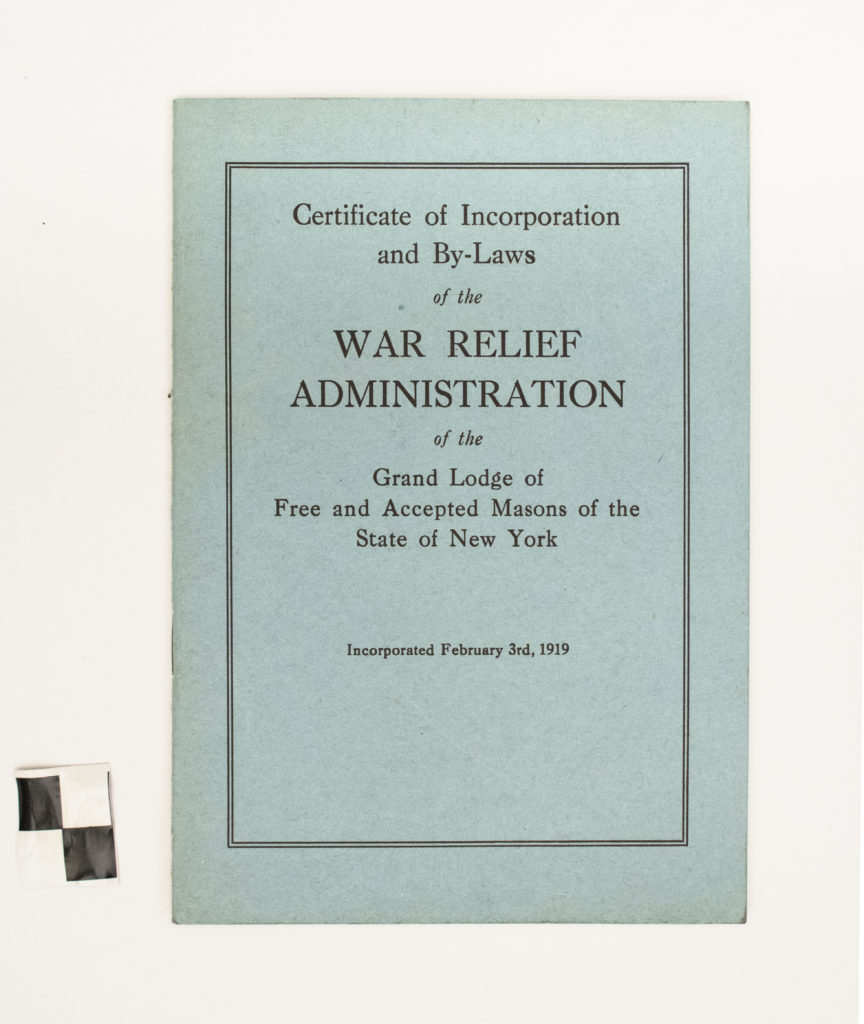
Furthermore, there was a copy of Brotherhood, and inserted within the pages of this journal was a photograph of Freemason John Lloyd Thomas, Secretary of the Masonic Home, Utica, N.Y. and a member of the Scottish Rite Bodies in the Valley of N.Y.C. John Lloyd Thomas was a 33rd degree Mason who lived in Utica, N.Y., and was a member of Benevolent Lodge No. 28, and was a writer and lecturer. He was also a onetime President of the Masonic Hall and Asylum Fund. His photograph was probably included in the copy of Brotherhood because he was the editor of this publication – dedicated to the Scottish Rite and other Masonic subjects of interest and published by the New York Bodies of the Scottish Rite and circulated to its membership from 1913 until it was discontinued in 1920.
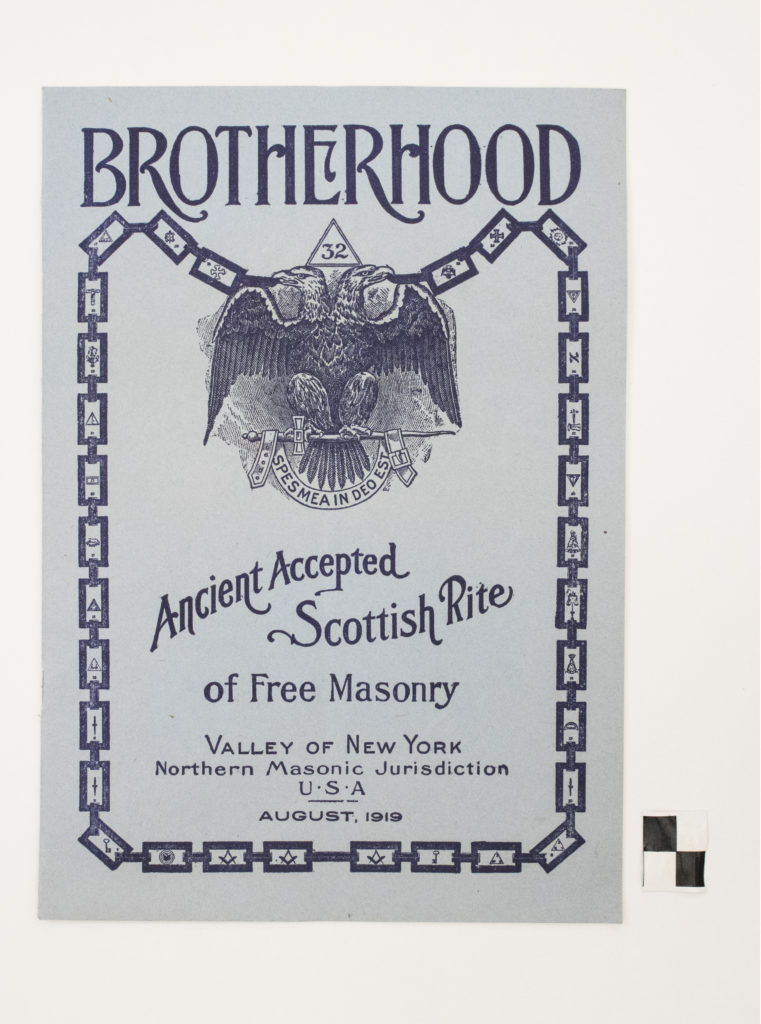
The August 1919 Issue of Brotherhood 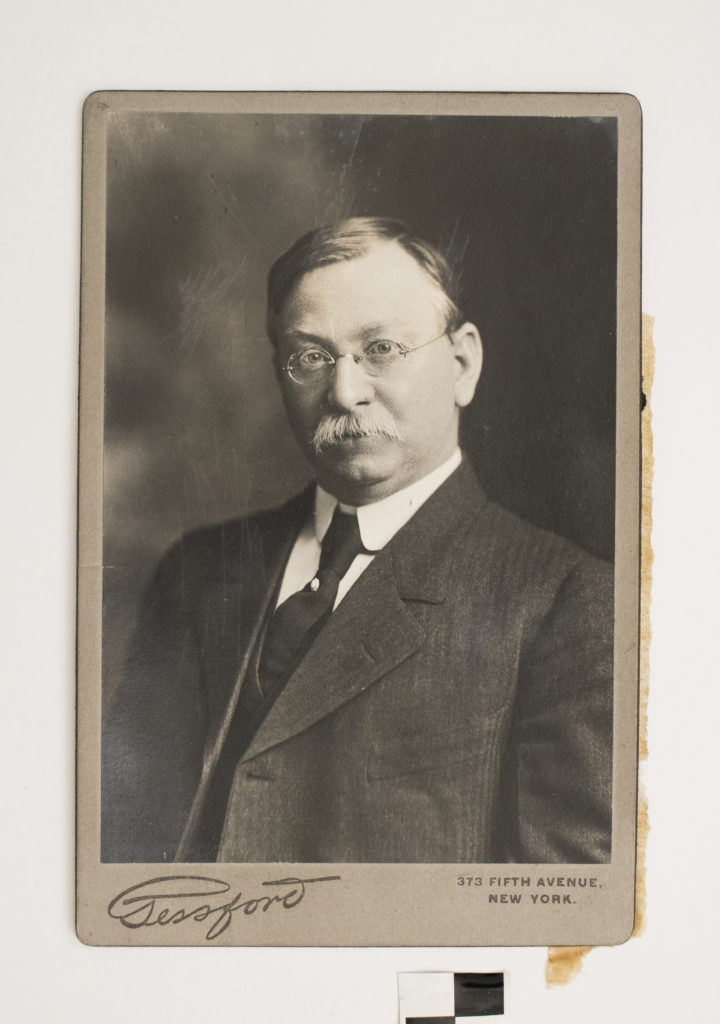
John Lloyd Thomas
Finally, there was even a book stamped by the Children’s Library at the Masonic Home in Utica, New York, that was found in the box – a copy of Literary Digest. Given the Masonic Home’s extensive history of caring for children before they transitioned more toward senior care, I was surprised that this book was included. It was not in the original inventory, but it has a sticker with “W. J. Wiley” printed on it, so I think Superintendent Wiley placed it in the box.
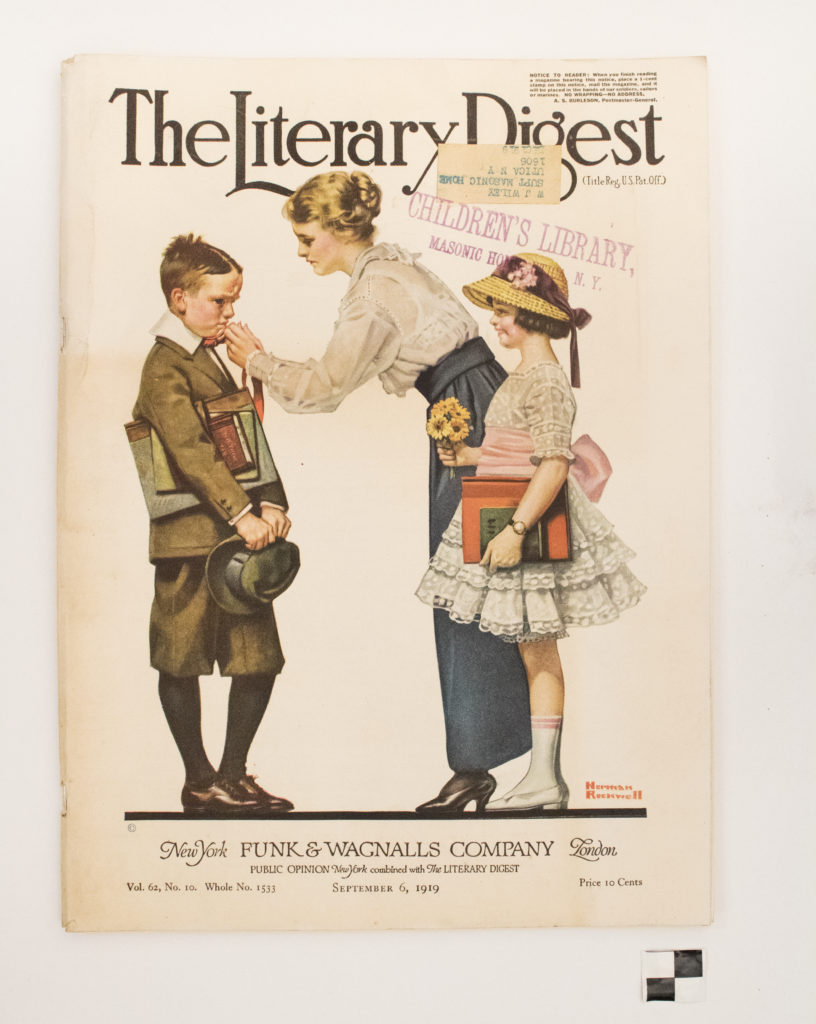
Medals and Plaque:
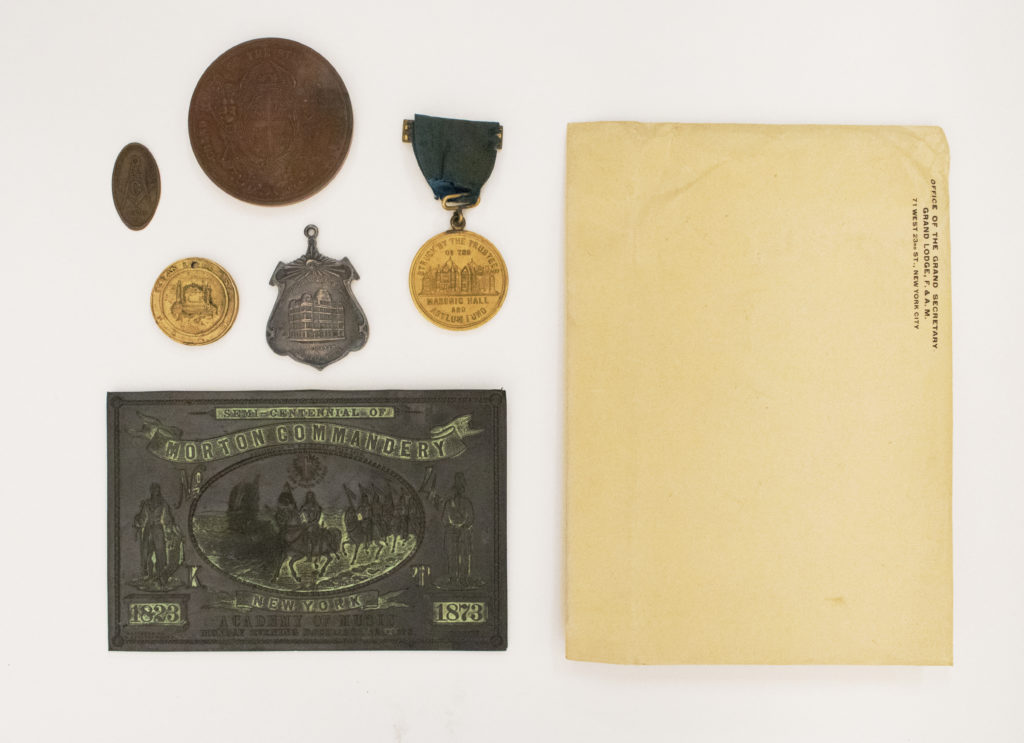
Furthermore, the time capsule contained an envelope with medals and a plaque inside that commemorated various significant New York Masonic events. These items were donated by R.’.W.’. Frederick J. Milligan, a Railroad Clerk by trade from Suffern, New York. He was a member of Lafayette Lodge No. 64, and was the Grand Sword Bearer in 1895. He later served as Acting Grand Secretary from June 1931-May 1932, and Grand Secretary Emeritus from 1932-1933. Following the death of MW Jesse B. Antony in 1905, he actually served as Superintendent of the Masonic Home in Utica until the appointment of William J. Wiley as Superintendent. The hospital might have meant something to him, as he was a member of Masonic Veterans.
One of the medals from the time capsule was this silver medal commemorates the dedication of the Masonic Temple in New York City on June, 2, 1875, that existed before the present New York Grand Lodge building. You can see the building on one side of the medal, and the other side of the medal shows the seal of the Grand Lodge of the State of New York. It took the Masons some time to raise the funds for the construction of this Grand Lodge Building, as due to inflation from the Civil War and the passage of time, the cost of the building increased to $1.5 million from an initial estimate of $35,000.00. Once built, the Grand Lodge Building proved to be more of a financial liability, as the debts from its construction were not settled until the 1880’s.
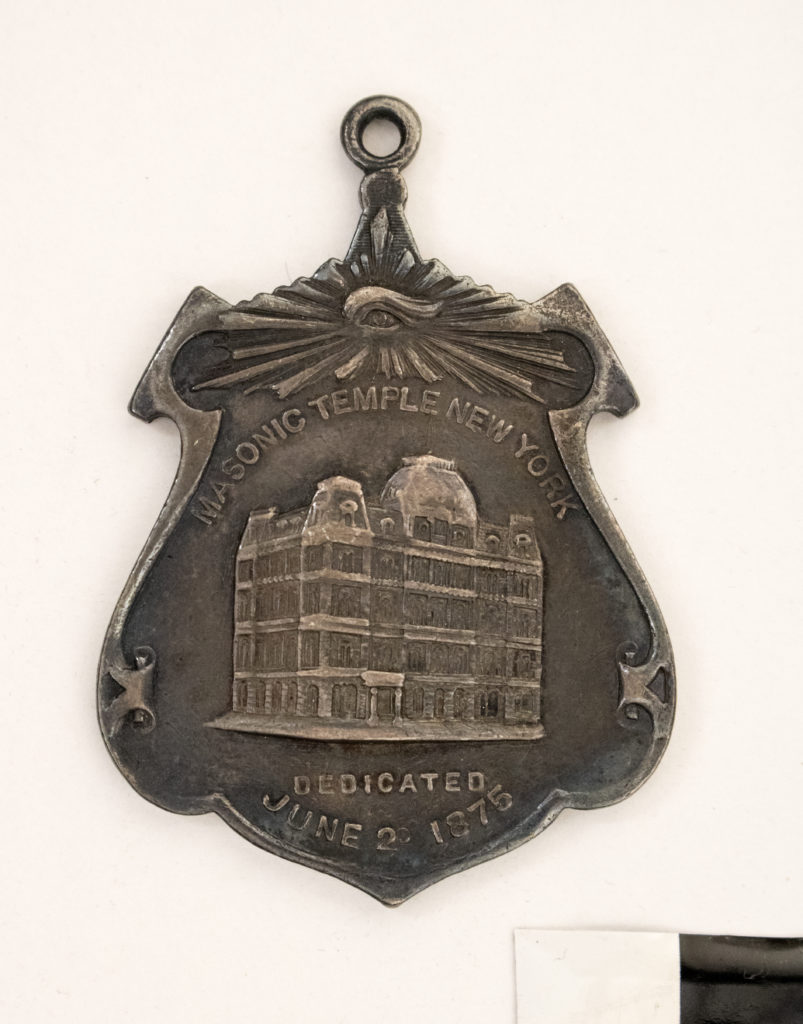
Front of 1875 Medal 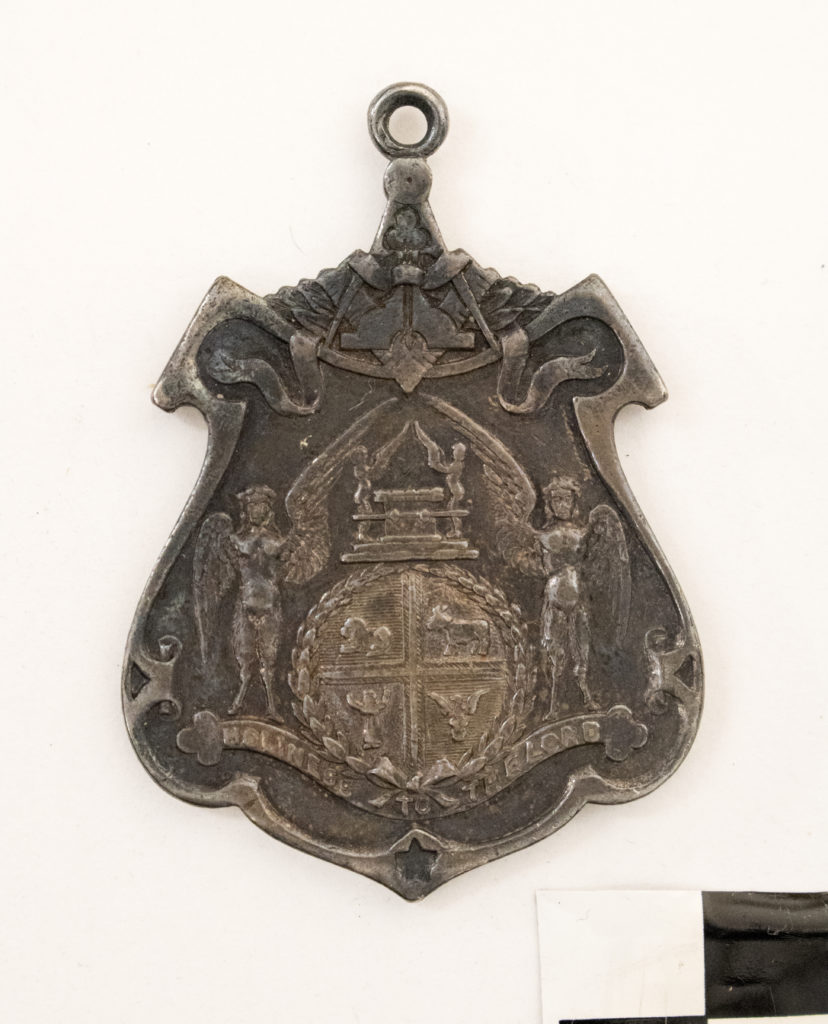
Back of 1875 Medal
The second medal found in the time capsule was a Bronze Medal to Commemorate the Freedom of the Craft from Debt, on April 24, 1889. This was an important date in New York Masonry, for it marked when Masonry had paid off all its debts from the construction of the 1875 Grand Lodge Building in N.Y.C. Grand Master Frank R. Lawrence was the Mason who was able to settle the debt: when he took office in 1885, the debt was $700,000.00, by the end of his term, there was a surplus of $200,000.00 in funds, which were soon earmarked for the construction of the Masonic Home in Utica. Therefore, not only was did this event mark when Freemasonry in New York became financially sustainable, but it also led to the construction of the Masonic Home campus in Utica, where the Soldiers’ & Sailors’ Memorial Hospital was built.
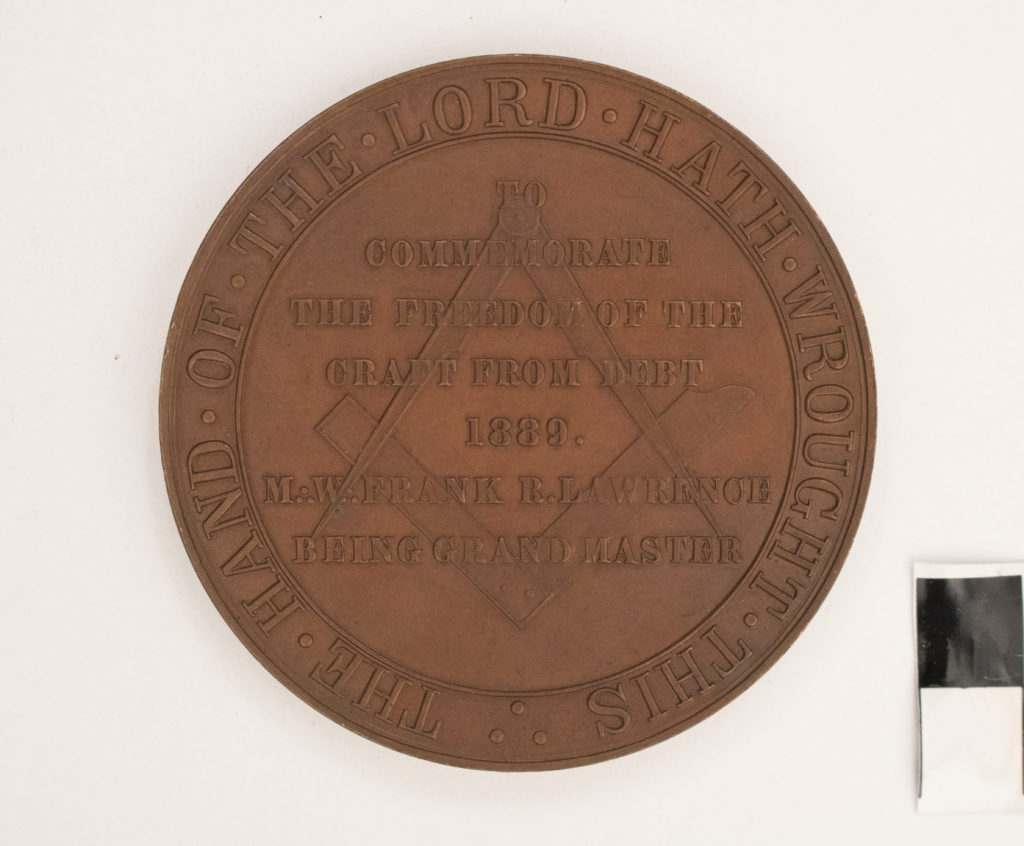
Front of 1889 Medal 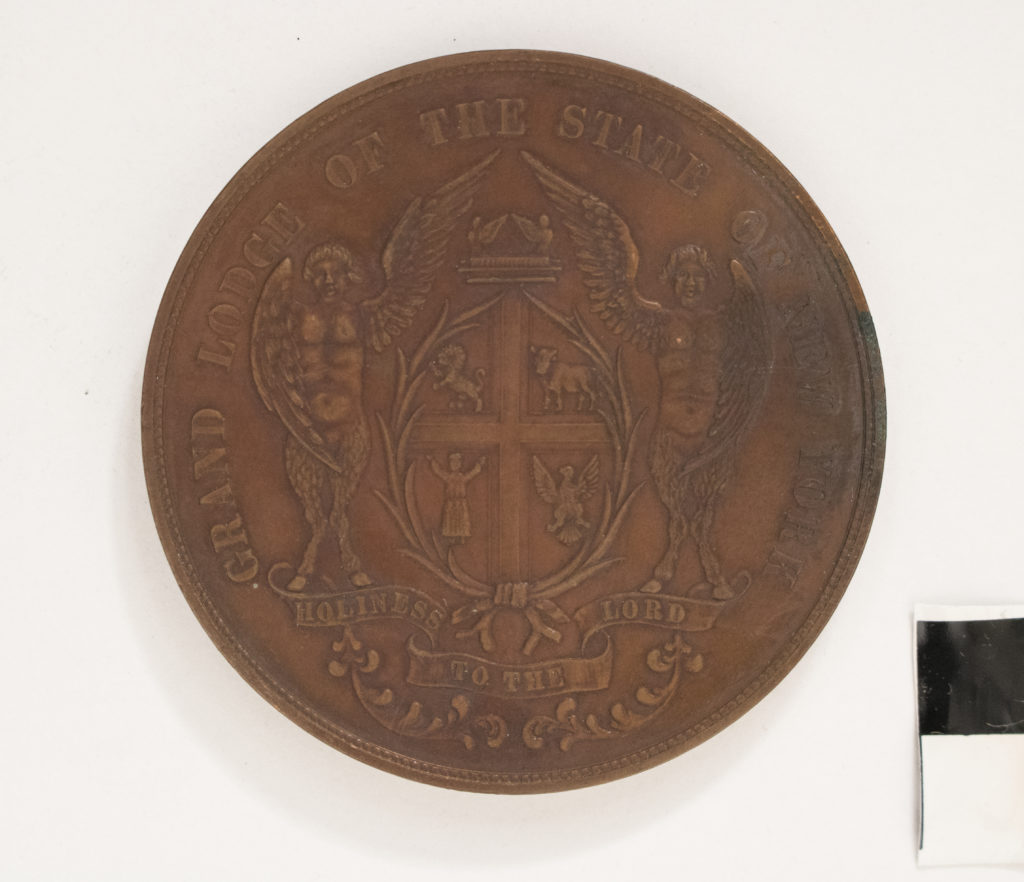
Back of 1889 Medal
The third medal found in the capsule was a Gilt Medal to Commemorate the Laying of the Corner Stone of the Masonic Asylum, Utica, New York, on May 21, 1891. The front of the medal shows the Old Administration Building. The gold bar on the medal’s ribbon, with the years 1842 and 1891 signifies the first time the idea of the Masonic Hall and Asylum was first suggested by Brother Greenfield Pote in 1842, and when the corner stone of the Masonic Hall and Asylum was laid in 1891. The Administrative Building was dedicated in October of 1892 and occupied by 1893. It could accommodate 150 people by administrative offices – in 1965, it was demolished to make way for a more functional one-story replacement building.
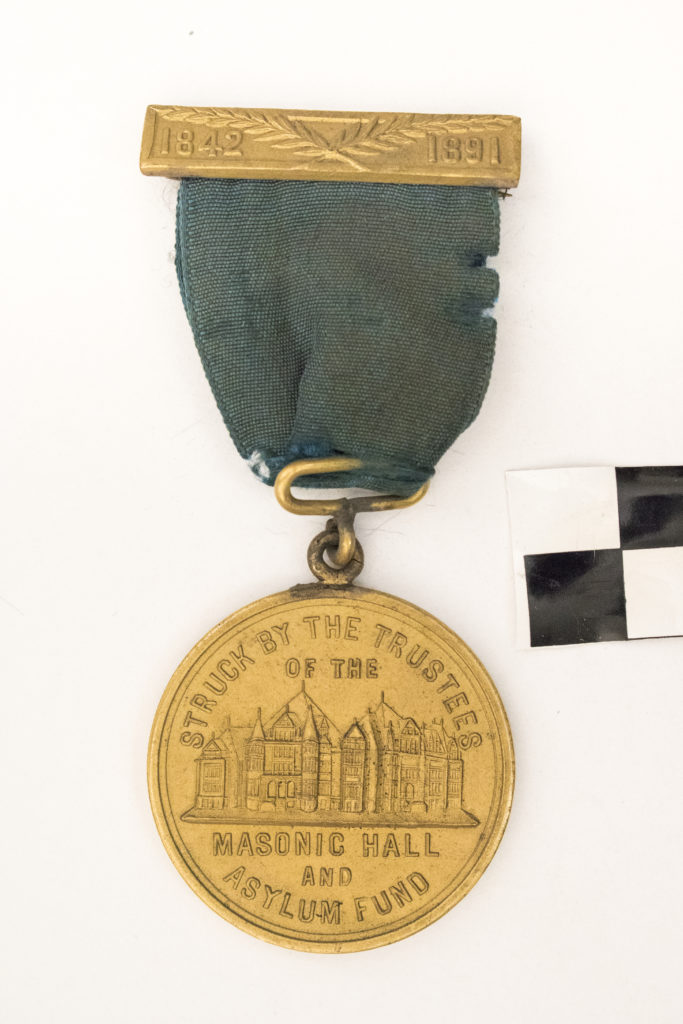
Front of 1891 Medal 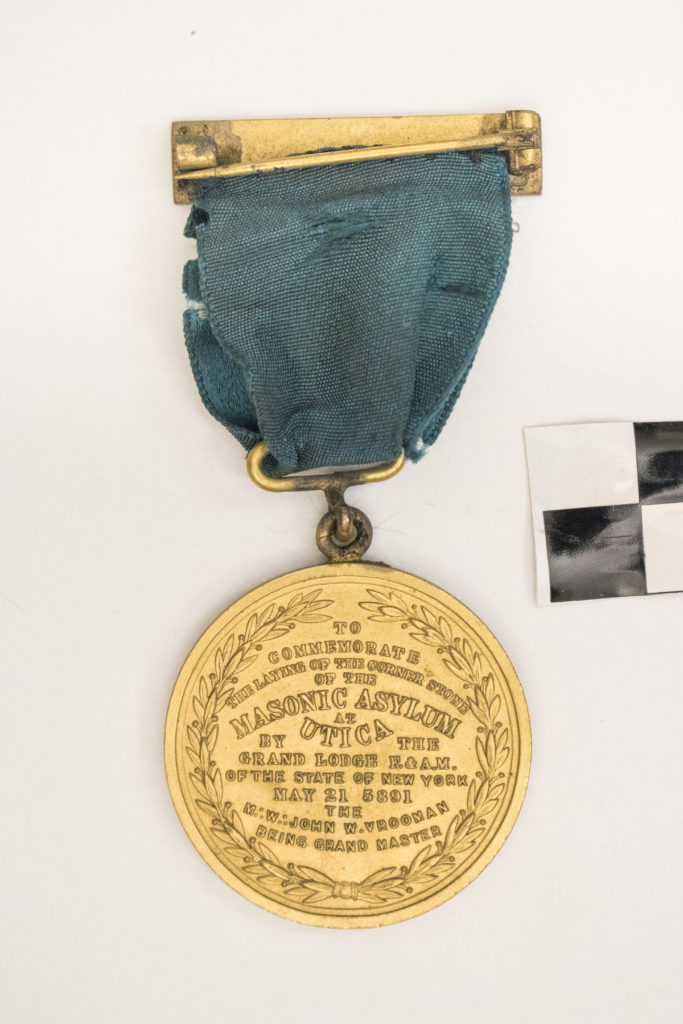
Back of 1891 Medal
Another medal found in the box was a Gilt Medal Struck by Ocean Lodge # 156. This Lodge was chartered on March 5, 1850 in New York (in Manhattan). This Lodge was involved in the dedication of the Worth Monument on Madison Square November 25, 1857; the corner stone laying of the Egyptian Obelisk in Central Park, and the dedications of both the present Masonic Hall Building and the Masonic Home in Utica. In addition, this Lodge was actively involved in fundraising for the Hall & Asylum Fund, and in June 1888 it had paid its full quota requested to help pay off the “great debt” of the Craft.
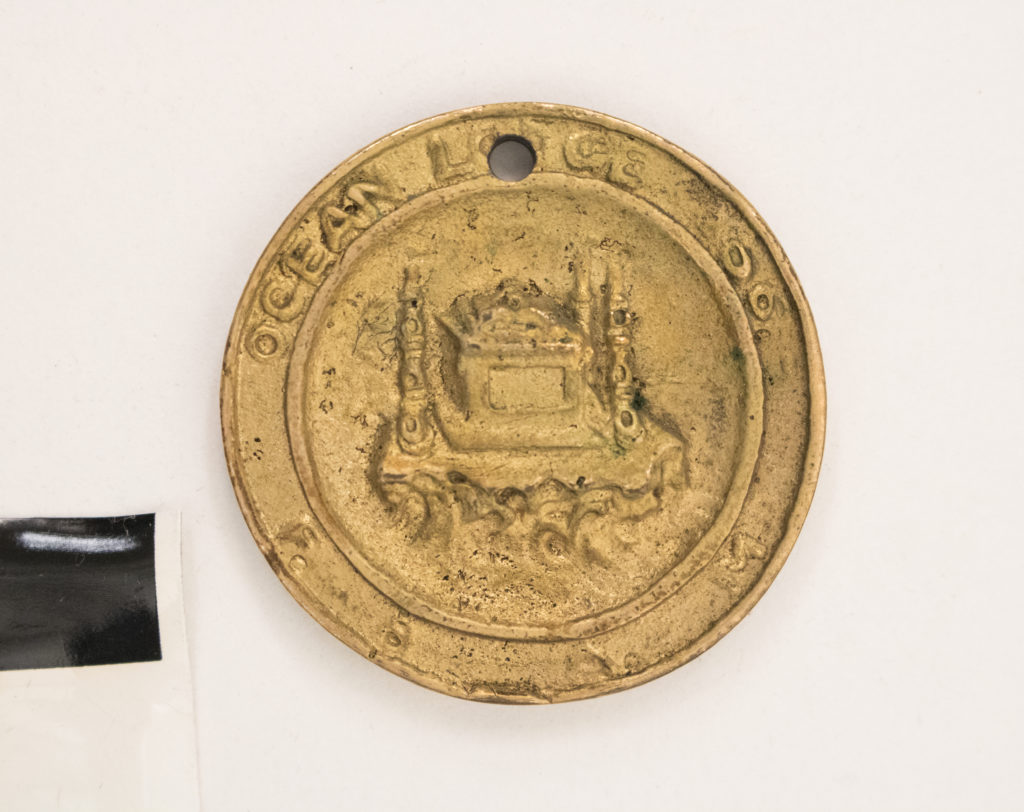
Also discovered with the medals was a Bronze Masonic Piece Struck at Pan American Exposition in 1901. My research did not reveal if the Masons has an exhibit at the Exposition, but this souvenir token may have been placed in the box to commemorate Freemason William McKinley, 25th President of the United States, who was assassinated at this Exposition.
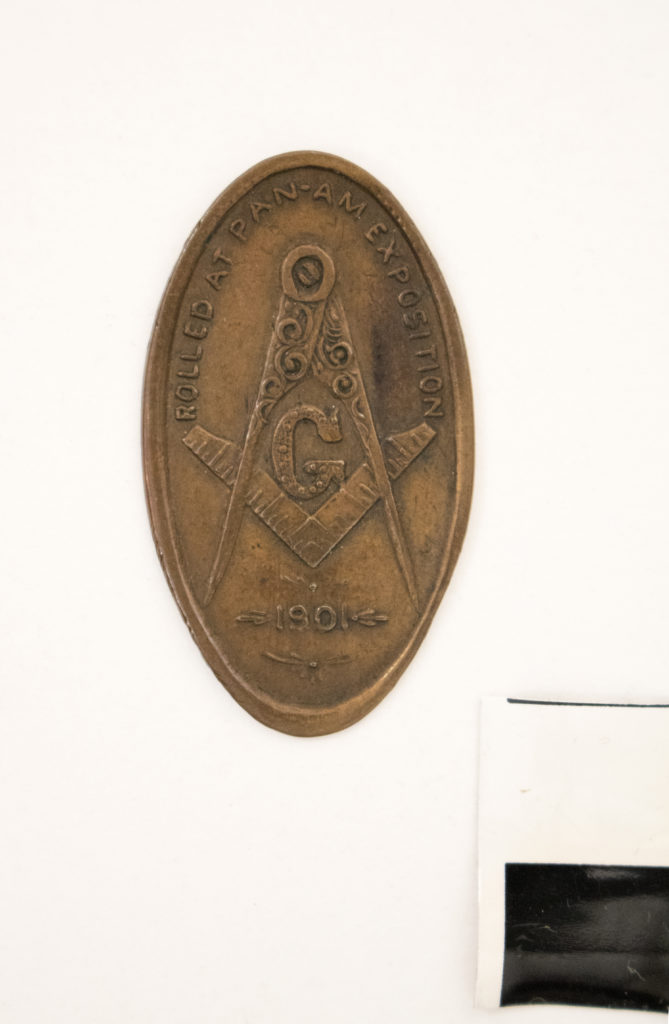
Finally, there was a Bronze Plaque of Morton Commandery No. 4, Knights Templar (of New York City) for their Semi-Centennial in 1873, or fiftieth anniversary. It makes sense that R.’.W.’. Frederick J. Milligan (mentioned earlier) would donate this plaque, as he was a member of Columbian Commandery No. 1, Knights Templar.
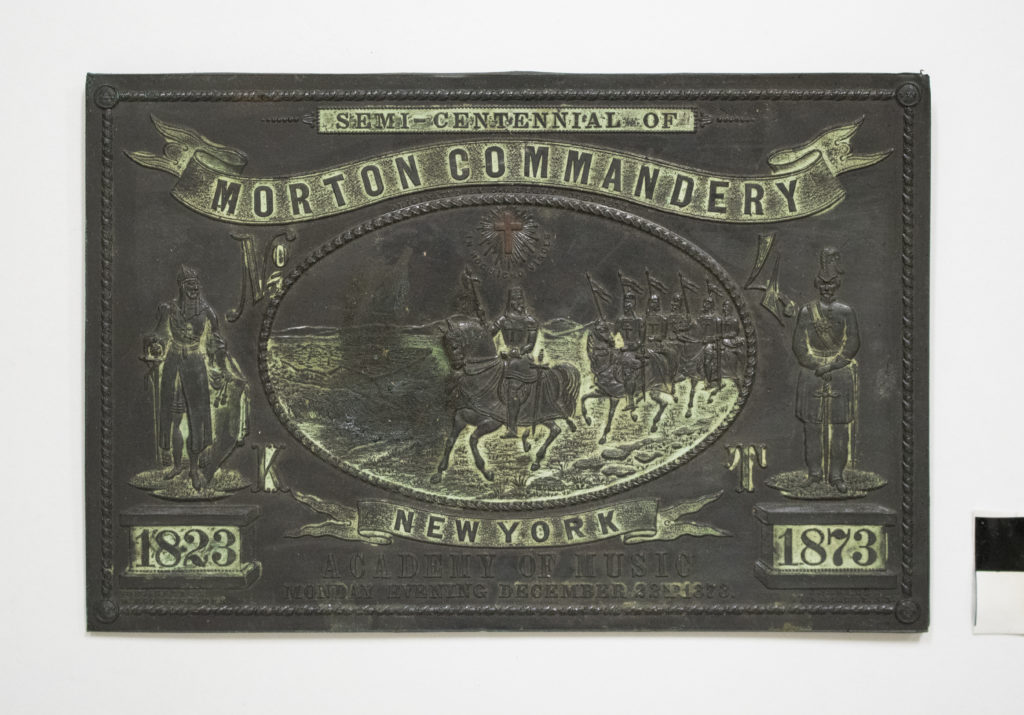
Stamps, Coins, Documents, and Other Items
In addition, there were also stamps, coins, and other items found in the time capsule.
American Stamps:
For example, a full set of 1919-era stamps were included, which give an idea of the postage used at the time: including stamps with portraits of George Washington and Benjamin Franklin (both Freemasons) as well as a Special Delivery stamp and the Curtiss Jenny Airplane stamp. The Inventory does not state who gave the stamps, but I think Freemason Charles H. Johnson gave them (whose photograph was mentioned earlier), since his biography file in the Library’s Vertical Files stated that he was “a stamp collector of more than local note.”
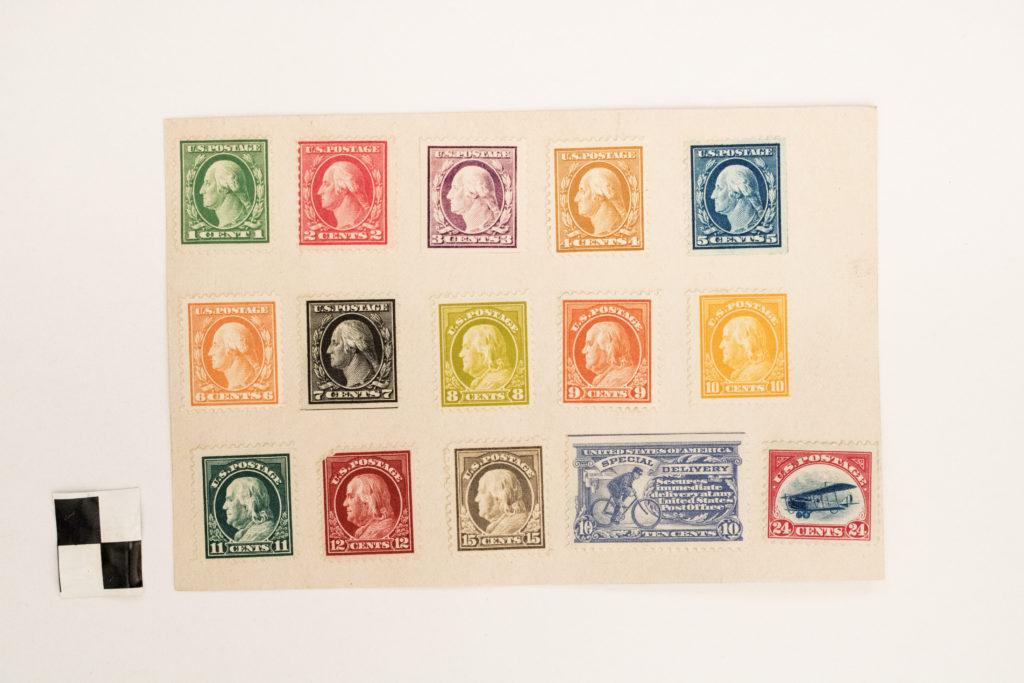
Coins:
The Inventory states that Brother George Chase gave the coins placed in the time capsule. My research revealed that he was a member of Lafayette Lodge No. 64, and that he was a jeweler by profession.
Some of these coins dated from the early twentieth century, which gives us an idea of what the typical currency was that was used in 1919. One of these coins was a copper 1919 wheat or “wreath” penny. It was designed by Victor D. Brenner and in circulation from 1909-1958, and created to commemorate the 100th anniversary of Abraham Lincoln’s birth, and was the first cent to include the motto “In God We Trust.”
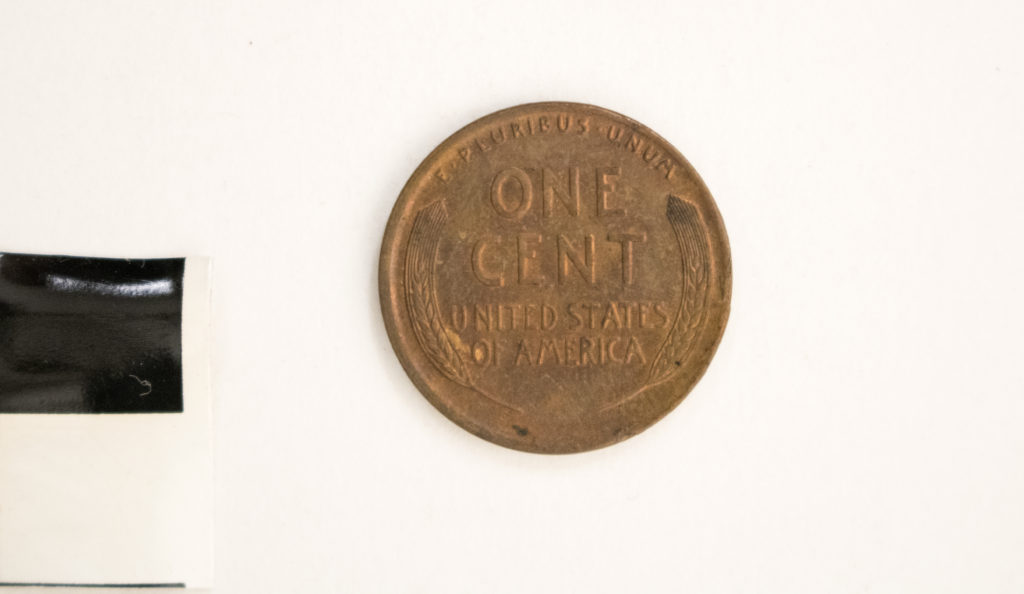
Front of 1919 Lincoln Cent 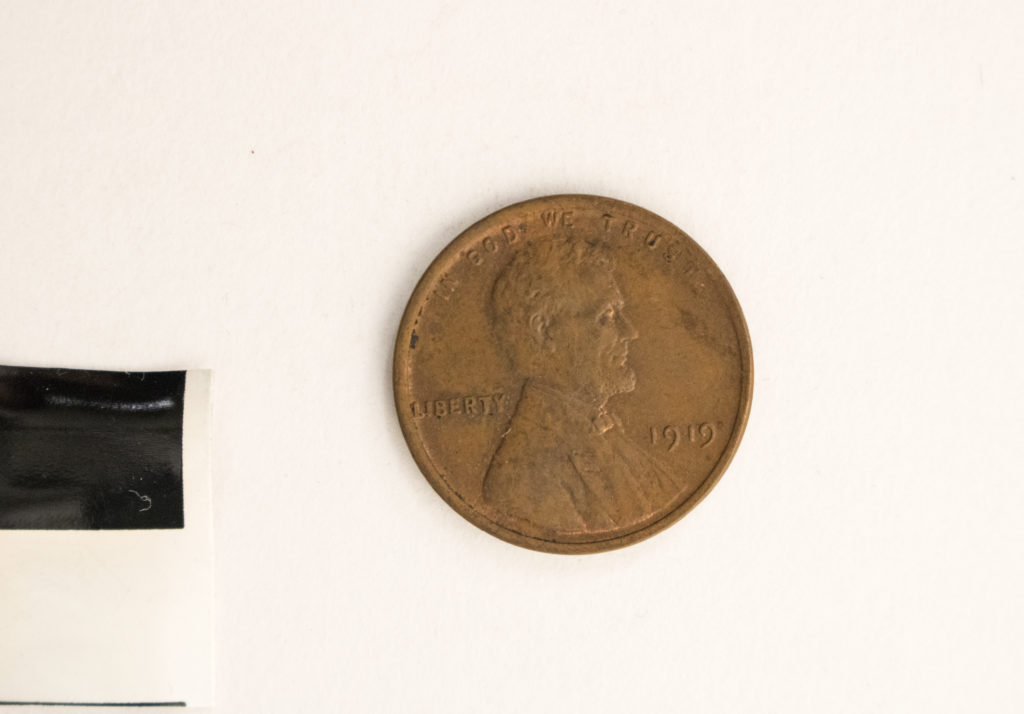
Back of 1919 Lincoln Cent
A second coin found in the box was a 1919 U.S. Nickel, also called the “Buffalo” or “Indian Head” Nickel. It was designed by James Earle Fraser and in circulation from 1913-1938. Fraser supposedly modeled the bison on the coin on the bison Black Diamond in the New York Central Park Zoo.

Front of 1919 Buffalo Nickel 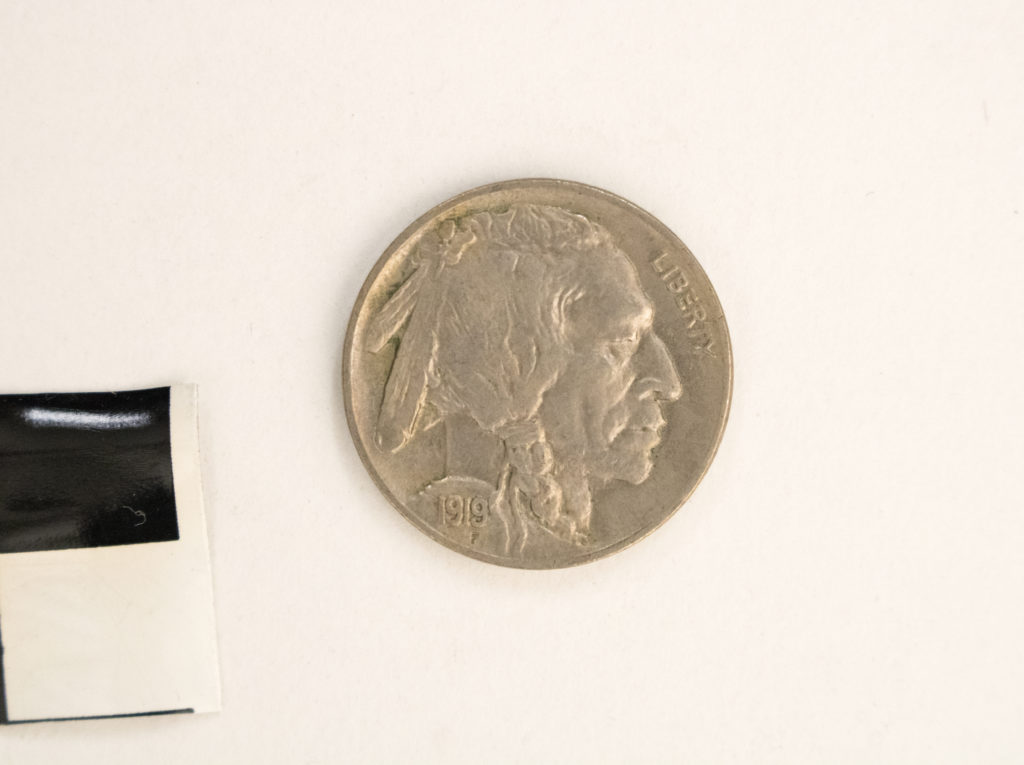
Back of 1919 Buffalo Nickel
Another coin discovered in the capsule was a 1917 U.S. Silver Quarter or “Standing Liberty” Quarter. It was designed by Hermon A. MacNeil, and in circulation from 1916-1930.
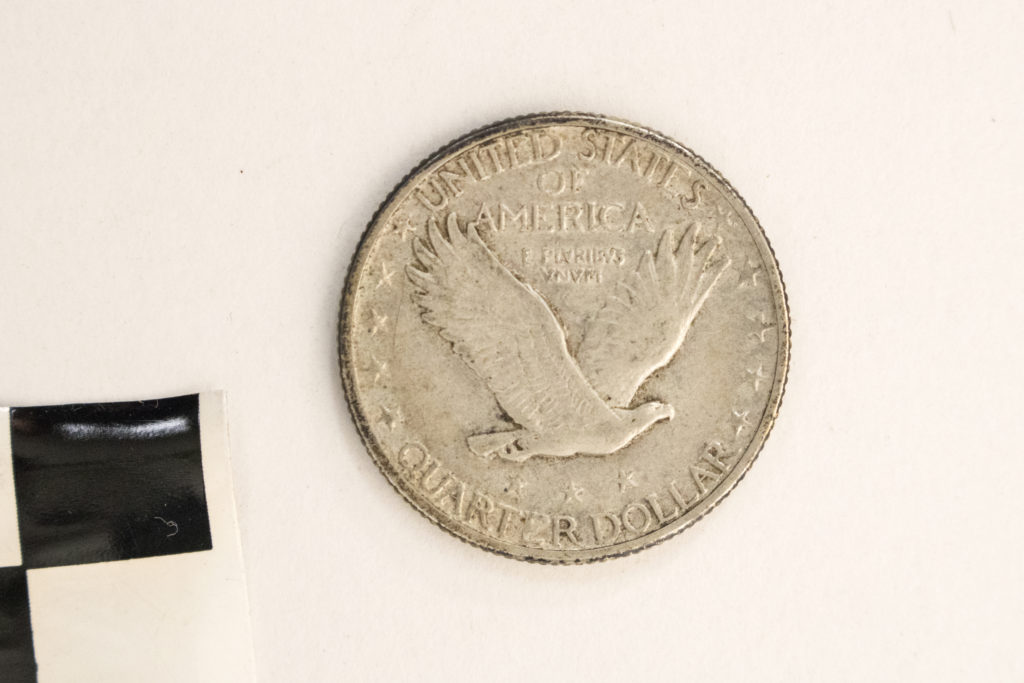
Front of 1917 Standing Liberty Quarter 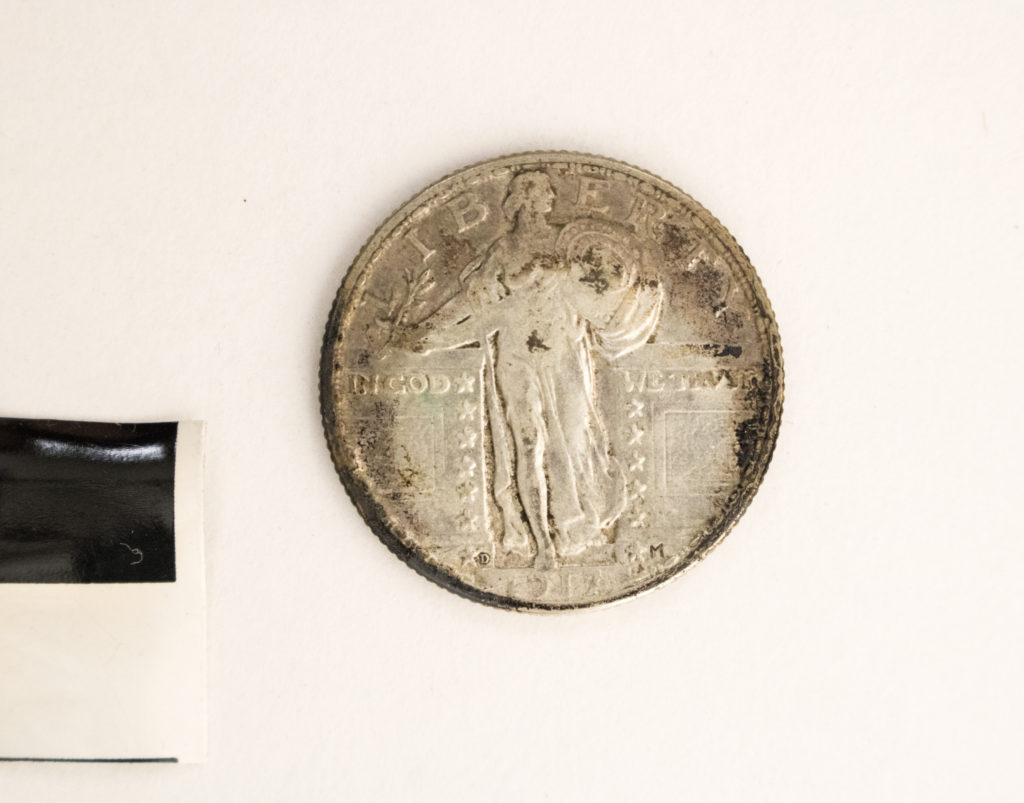
Back of 1917 Standing Liberty Quarter
Finally a 1915 U.S. Silver Dime or the “Barber”/”Liberty Head” Dime was found in the capsule. Its Obverse was designed by Charles E. Barber (chief engraver of the U.S. Mint at the time), but its reverse was created by James B. Longacre in 1860 for the Liberty Seated Dime, and it was in circulation from 1892-1916.
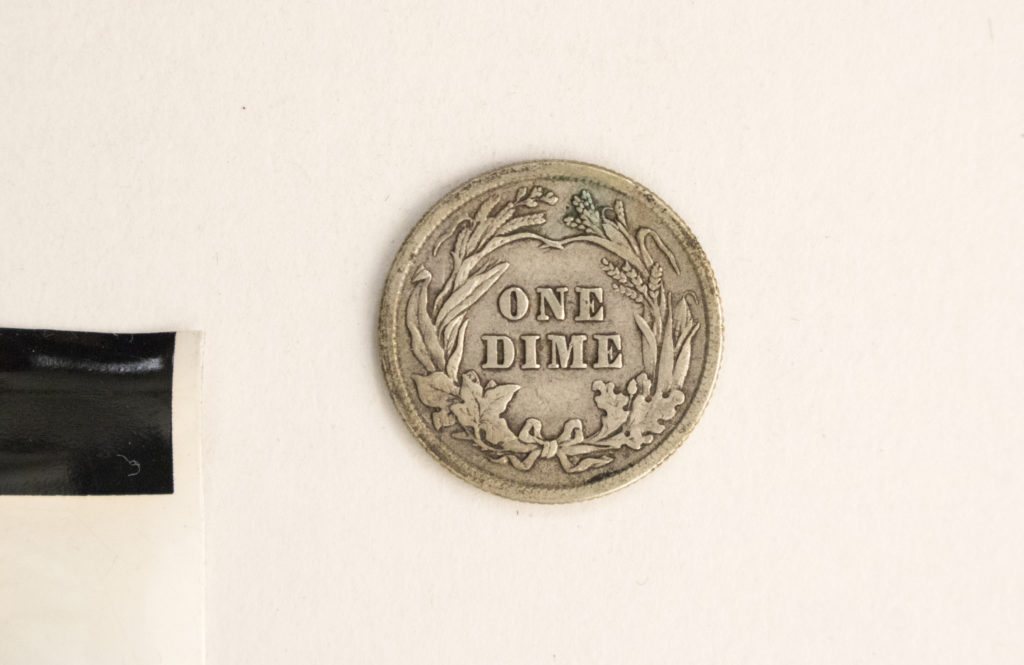
Front of 1915 Barber Dime 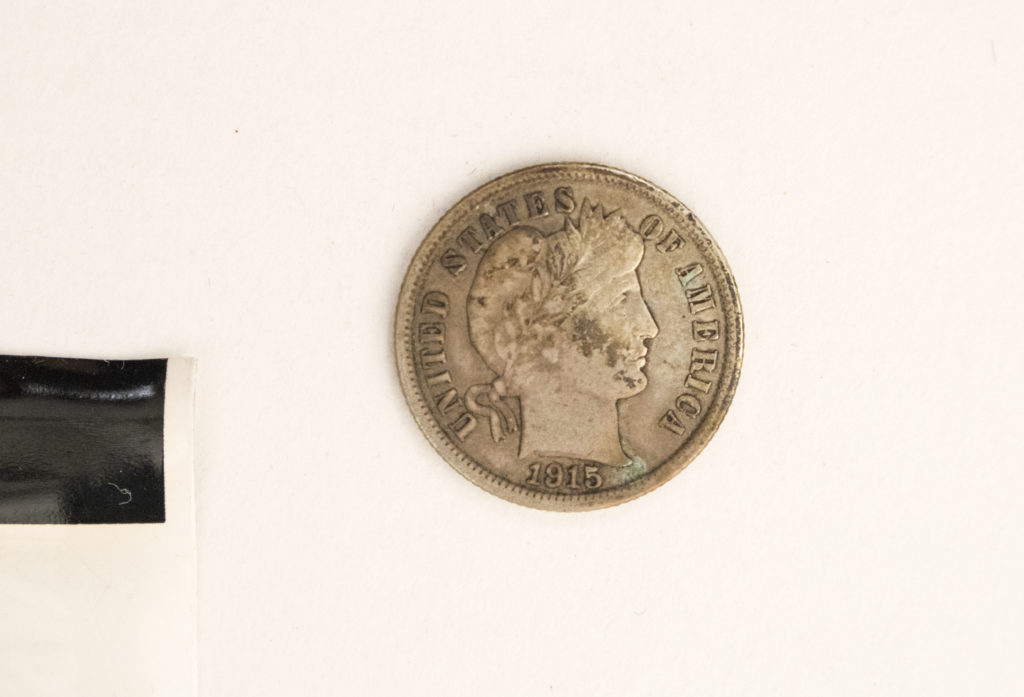
Back of 1915 Barber Dime
The time capsule also contained several nineteenth century coins that were older than the 1910’s. The first of these coins that was found in the capsule was the 1893 U.S. Silver Half Dollar from the Chicago Columbian Exposition of 1893. In was issued for just 2 years from 1892-1893 during the Exposition. Unlike the other coins in the time capsule, this coin was a commemorative coin, with a portrait of Christopher Columbus on one side and his ship with two globes on the other.

Front of 1893 Half Dollar 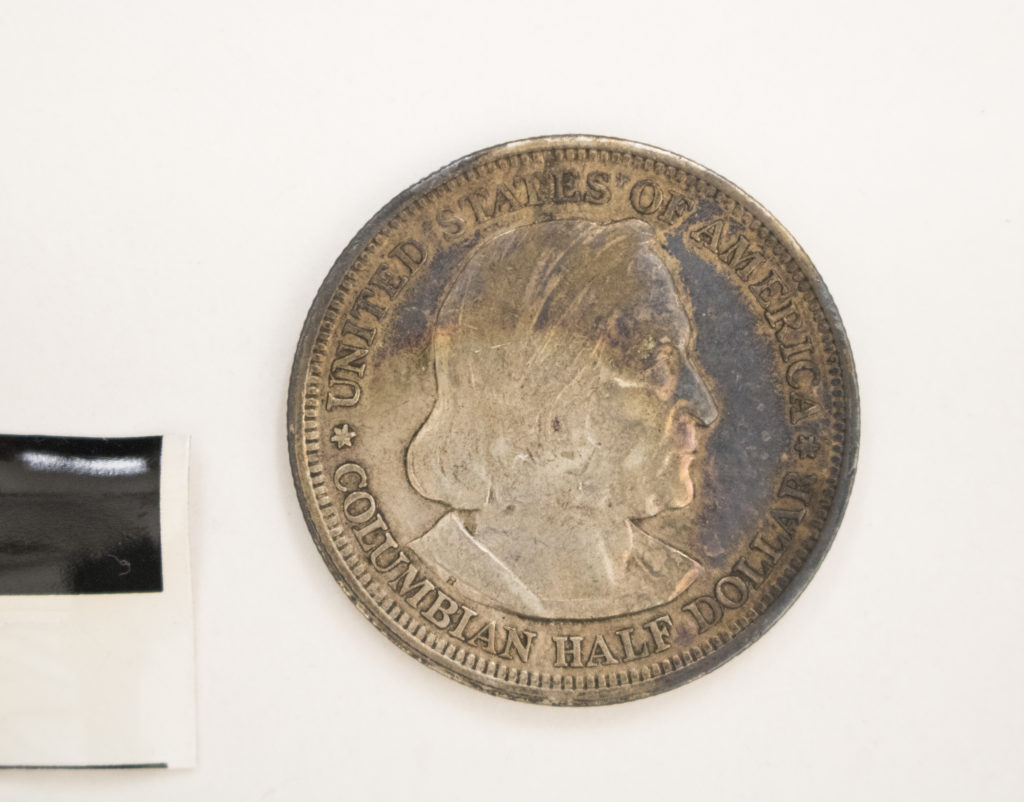
Back of 1893 Half Dollar
In addition, there was an 1864 U.S. Two-Cent Coin. An Act of April 22, 1864, included a provision for a bronze two-cent coin, designed by James B. Longacre, and in circulation from 1864-1873. This was the first time the motto “In God We Trust” was placed on a circulating coin. The two-cent coin was predicted to become widely used, by the introduction of the three-cent nickel in 1865 and the five cent nickel in 1866 decreased the demand for this coin, and the Coinage Act of 1873 abolished this form of denomination in U.S. currency.
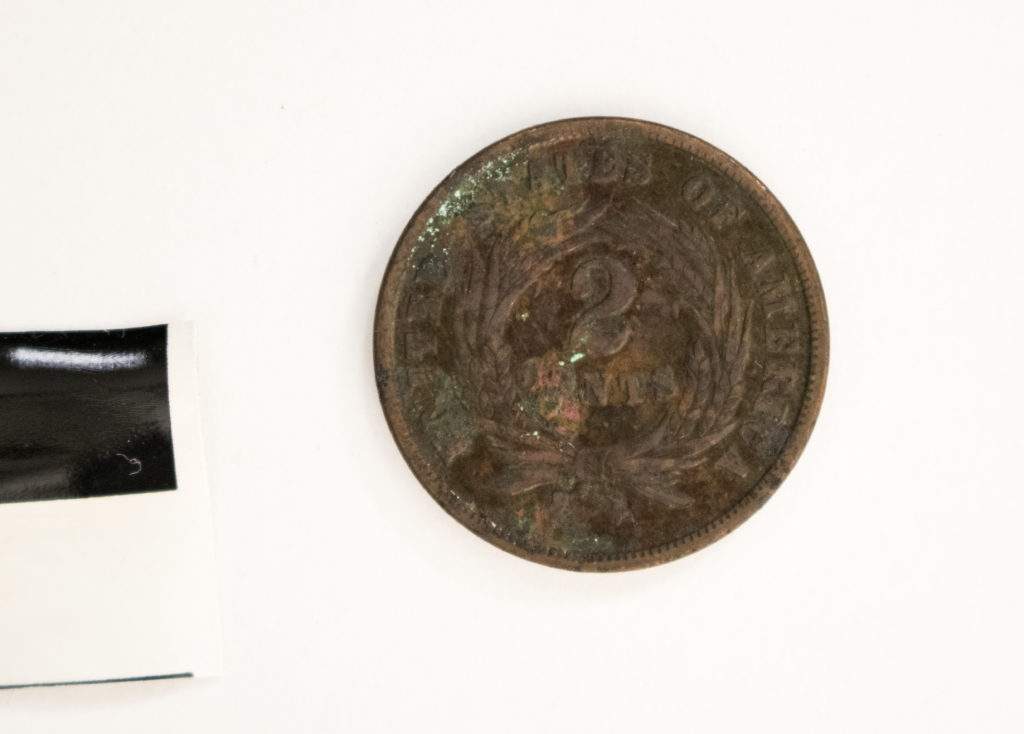
Front of 1864 Two-Cent Coin 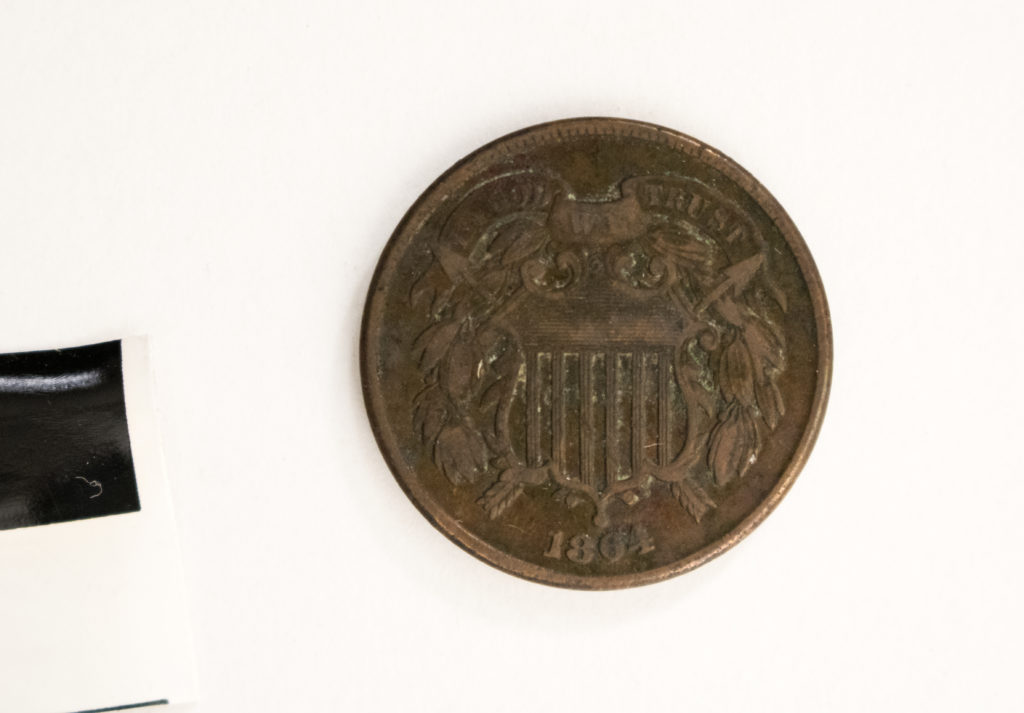
Back of 1864 Two-Cent Coin
There was also the 1819 U.S. Copper One-Cent Coin, also called the “Matron Head Large Cent.” It was designed by Robert Scot and in circulation from 1816-1836. Beginning in 1850, the U.S. Mint wanted to make smaller cents to replace the large cent to increase profits and create a coin that was convenient for users to handle. Production of large cents was officially discontinued by an Act of February 21, 1857.
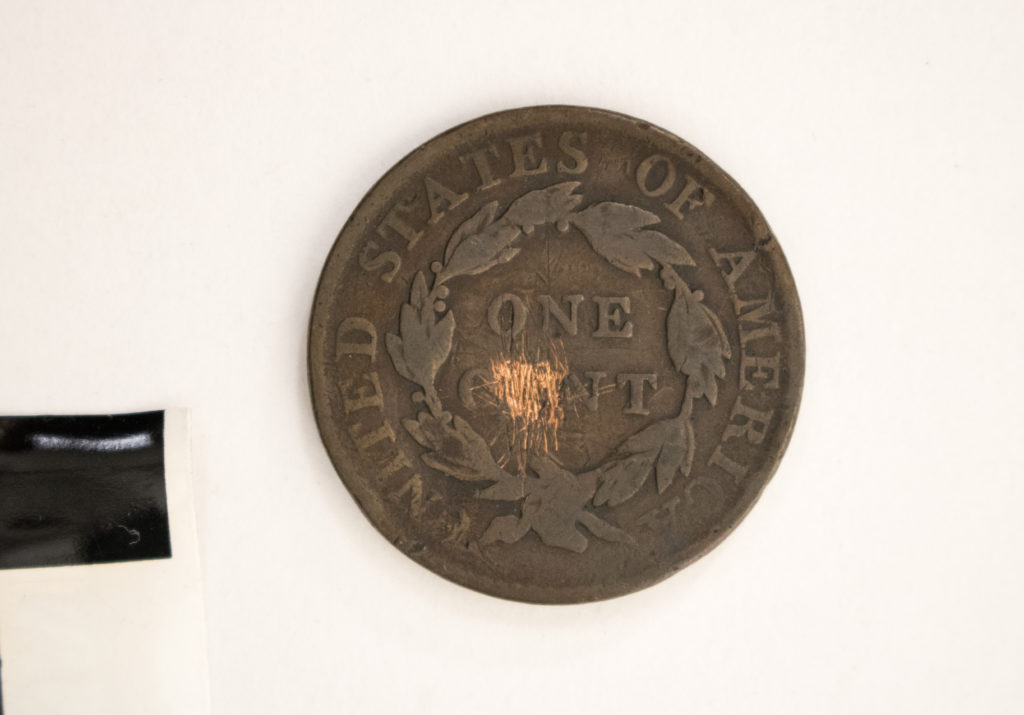
Front of Matron Head Large Cent 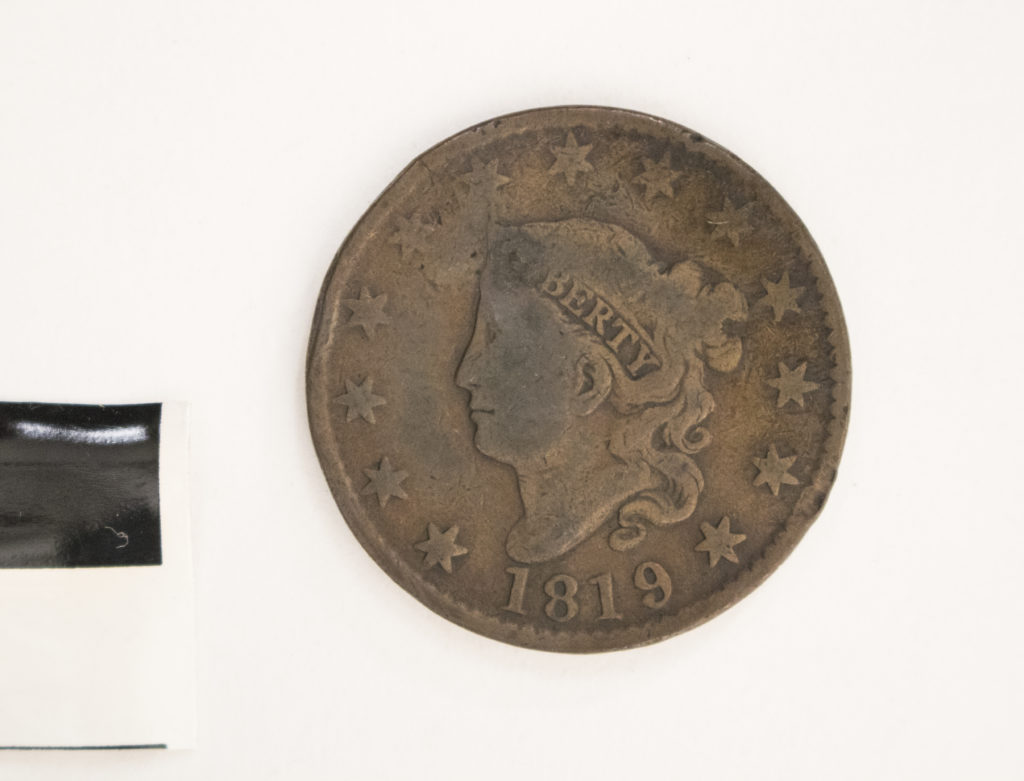
Back of Matron Head Large Cent
Finally, the oldest coin found in the time capsule was the 1804 U.S. Copper Half-Cent Coin or “Draped Bust Half Cent.” It was designed by Robert Scot and was in circulation from 1800-1808. The Mint Act of April 2, 1792, provided the half cent as the smallest denomination in American coinage, and these cents were expected to be popularly used for commerce, but they very never very popular with the public, and the Coinage Act of 1857 discontinued their production.
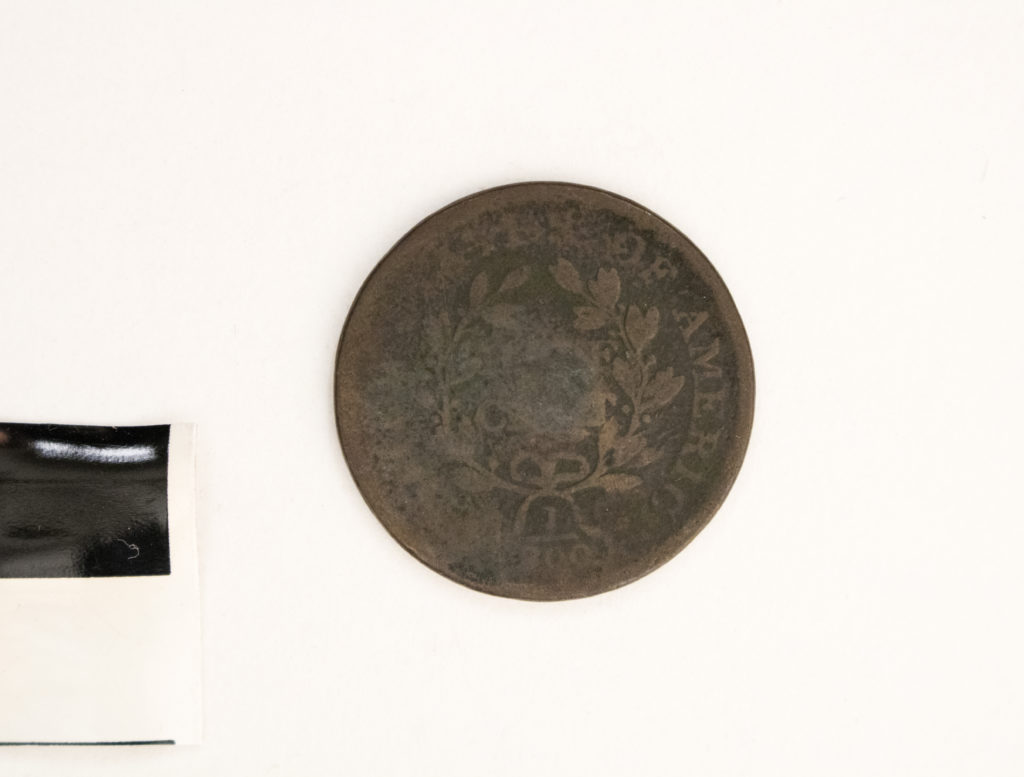
Front of Draped Bust Half Cent 
Back of Draped Bust Half Cent
Pamphlets:
There were also pamphlet in the time capsule that indicated Masonic events. A pamphlet found in the capsule describes the order of the many exercises for the September 20, 1919 laying of the corner stone of the Soldiers & Sailors Memorial Hospital: some included: A Prayer, said by R.’.W.’. and Rev. C. Wallace Petty, D.D., Grand Chaplain; A Presentation of the Box by R.’.W.’. Christopher C. Mollenhauer, Grand Treasurer; A Reading of the Contents of the Box by M.’.W.’. Robert J. Kenworthy, Grand Secretary, followed by Music; and The Depositing of the Box in the Corner Stone by the Grand Treasurer. There was also a pamphlet that describes the Masonic Meeting on the ship S. S. “Noordam” on July 1, 1919. This pamphlet lists the order of events for this Masonic Meeting: the Prayers, the Chairman’s Address, other Addresses, Songs, and the Roll Call; as well as a directory of all the masons who attended the meeting and their Lodges.

Corner Stone Laying Program
September 20, 1919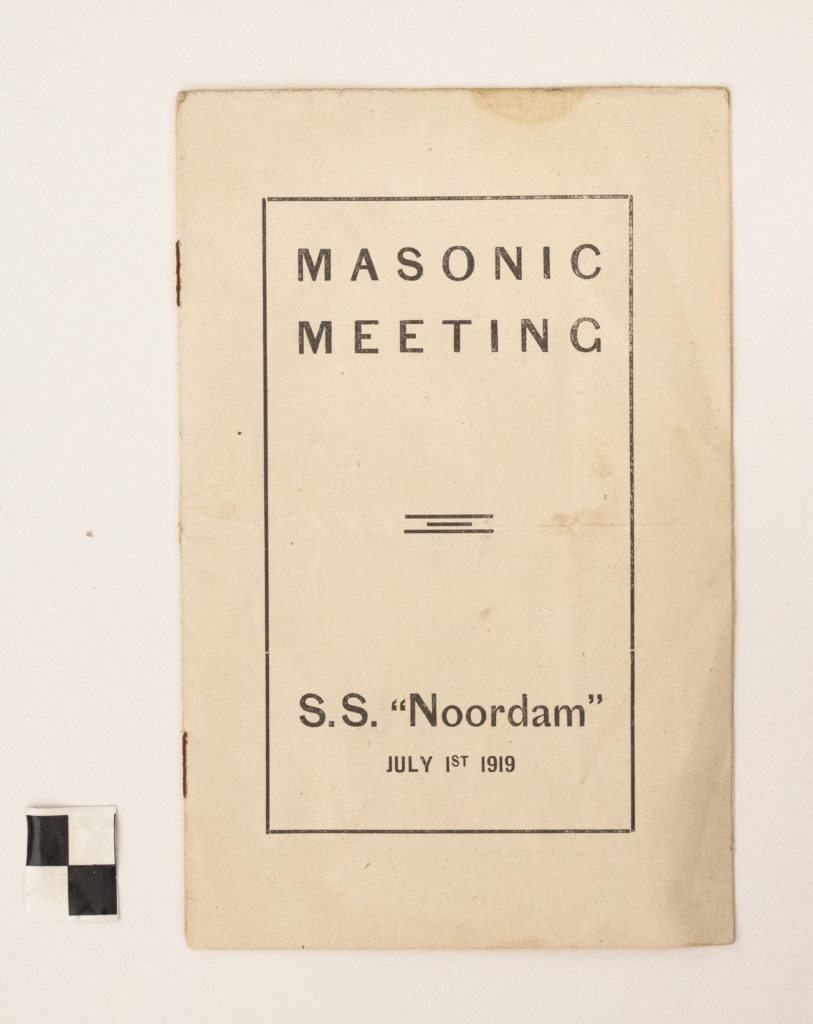
S.S. “Noordam” Masonic Meeting Program
July 1, 1919
Program and Letter:
There was a program from the United Grand Lodge of England’s “Peace Jubilee Celebration” from June 23-29, 1919, in London, England at the end of World War I also found in the capsule. The program lists meeting of the Masons in England during this period, and lists some of the site that they visited, such as the House of Parliament and St. Paul’s Cathedral. A letter from September 9, 1919 found in the box states that Grand Secretary Robert H. Robinson included it in the box.
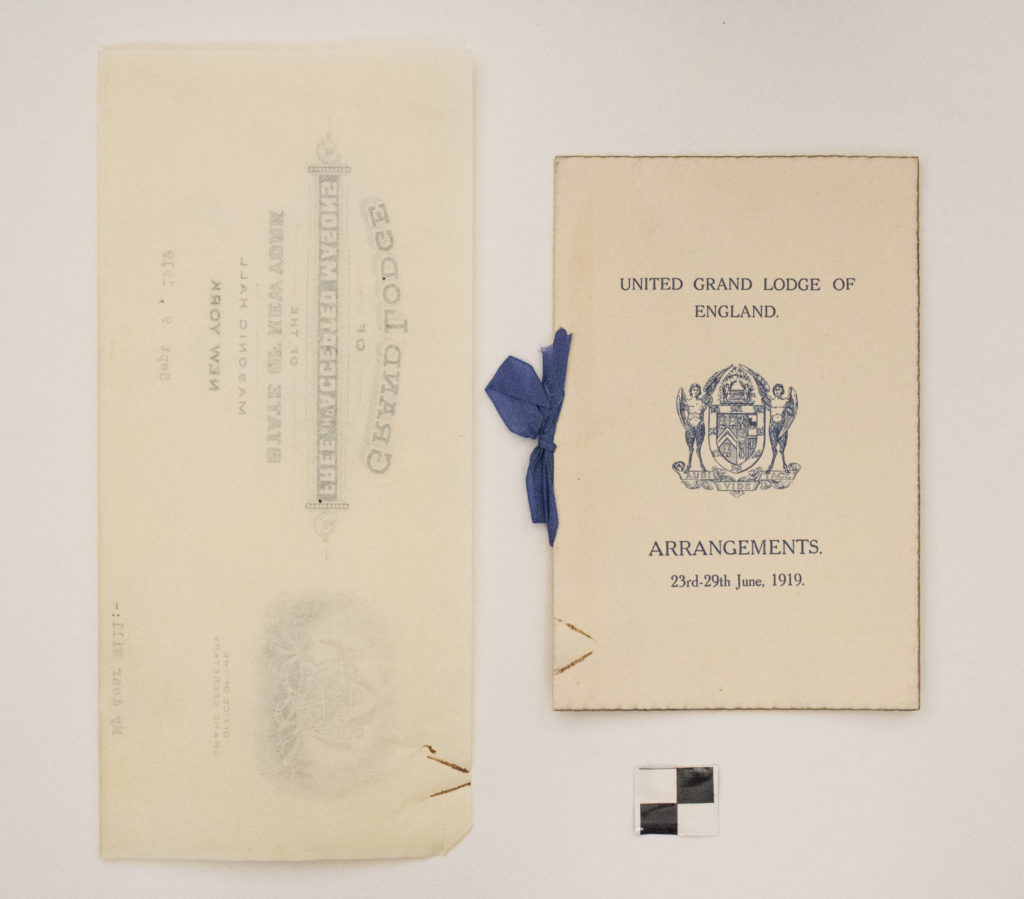
Facsimile of a Certificate of Exemption and a Masonic Apron:
Also found in the box was a facsimile of a Certificate of Exemption issued to Dirigo Lodge No. 30 on January 31, 1887 – to exempt Dirigo Lodge No. 30 from paying dues to the New York Grand Lodge since they had already “paid a sum equal to Six Dollars for each Member” to the Grand Lodge (the total was $924.00).

There was also a Masonic Apron worn at the laying of the corner stone of the Masonic Asylum, in Utica, N.Y., on May 21, 1891. According to the Inventory, the Certificate and Apron were donated by R.’.W.’. Aaron Morris, of 175 Fifth Avenue, New York City, who served as the Grand Steward from 1901-1902, and was a member of Dirigo Lodge No. 30 of the 1st Manhattan District. This explains why he put the Dirigo Certificate in the time capsule.

Yearbook and Lodge Event Notice:
Additional items discovered in the box was a 1919 yearbook and Lodge event notice. The yearbook is for St. John’s Lodge No. 1, and lists the Masonic Officers of the Lodge, when the Lodge met in 1919, a directory of their members, and other information. The event notice announces an Address given by Freemason Colonel Walter C. Montgomery, Chief Surgeon of the 27th Division of the American Expeditionary Forces, at St. John’s Lodge No.1, on April 10, 1919, as a “welcome home” event, where he told his Masonic Brothers stories of his war experiences. Colonel Montgomery was awarded the Distinguished Service Medal during World War I, when, in action along the Hindenburg Line from 25-30 September, 1918, with limited medical personnel he was able to successfully evacuate 4,000 casualties in four days.
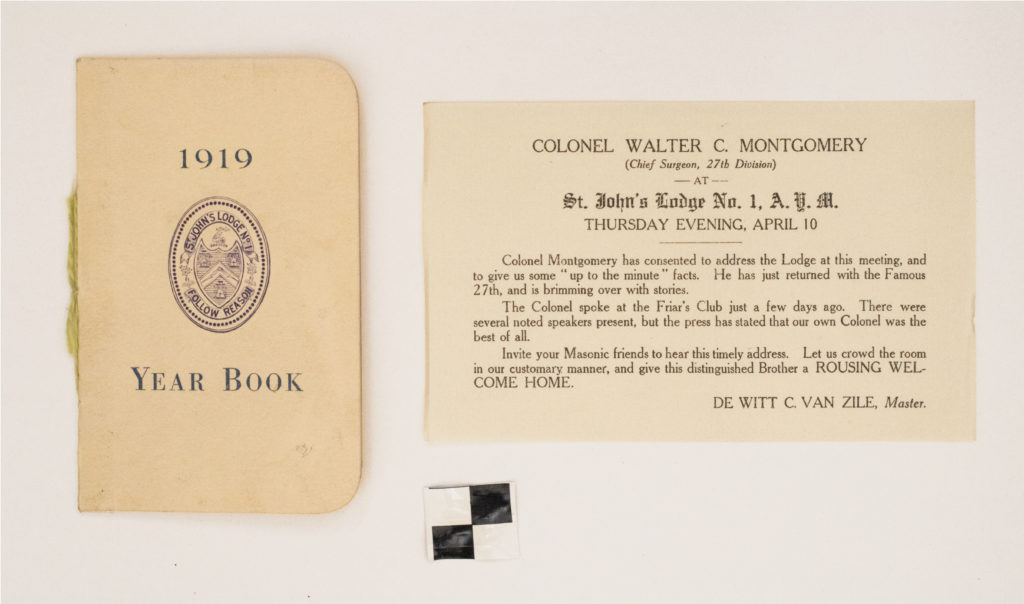
Copy of the Address Delivered by R.’.W.’. Cornelius Woelfkin, D.D., at the Laying of the Corner Stone:
The box also had a copy of the Address Delivered by R.’.W.’. Cornelius Woelfkin, D.D., at the Laying of the Corner Stone for the Soldiers & Sailors Memorial Hospital. The entire address (it is thirteen pages long) mainly discusses the larger significance of the corner stone laying, relating it to the history of international and American Freemasonry, as well as the history of hospitals in Western civilization. R.’.W.’. Woelfkin stated:
“So to-day, were are convened in the ceremony of laying a cornerstone. It is a common function which takes place with the erection of every communal or public building, whether devoted to religious, charitable or official usage. But such a ceremony, like Raphael’s painting and Israel’s Passover, has an inside as well as outside meaning. The formal placing of a stone to join the walls, the depositing of a few archives and memorials of our generation, which other generations may or may not read, these are outside features which could be performed without our presence. Why then are we assembled in such numbers and with such formality to witness this common act? We are here for something more than a holiday and the passing exchange of friendly greetings. We bring memory, imagination, conscience, reason and will to this occasion; and by a concentration of all these faculties we aim to commune with the invisible and spiritual realities toward which all our symbols point.”
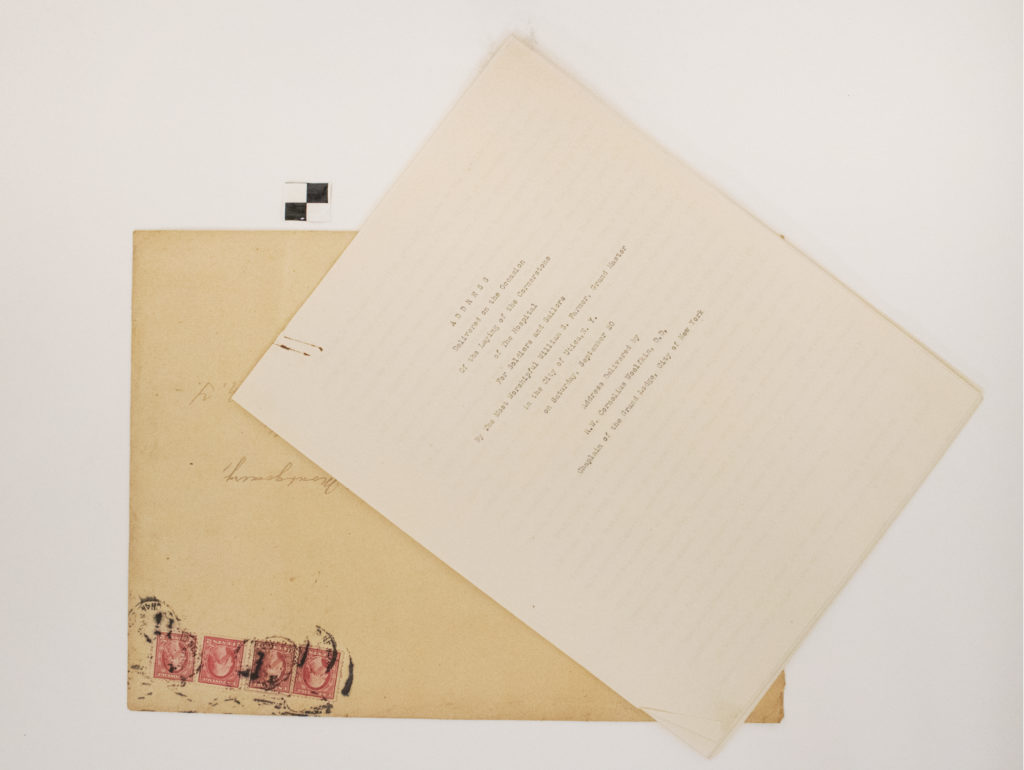
A Weather Report:
Finally, the last artifact from the time capsule was a weather report from the day of the corner stone laying. This is what it said: “September 20th, 1919: Nine O’Clock A. M.: Wind southwest. It rained from about One A. M. to Eight A. M. – very high wind. At this writing the wind still continues high – the sky cloudy and looks anything but a promising day for the ceremonies of the laying of the stone. P. S. Eleven O’Clock A. M. Beautifully clear. Every prospect of a sunshining afternoon.”
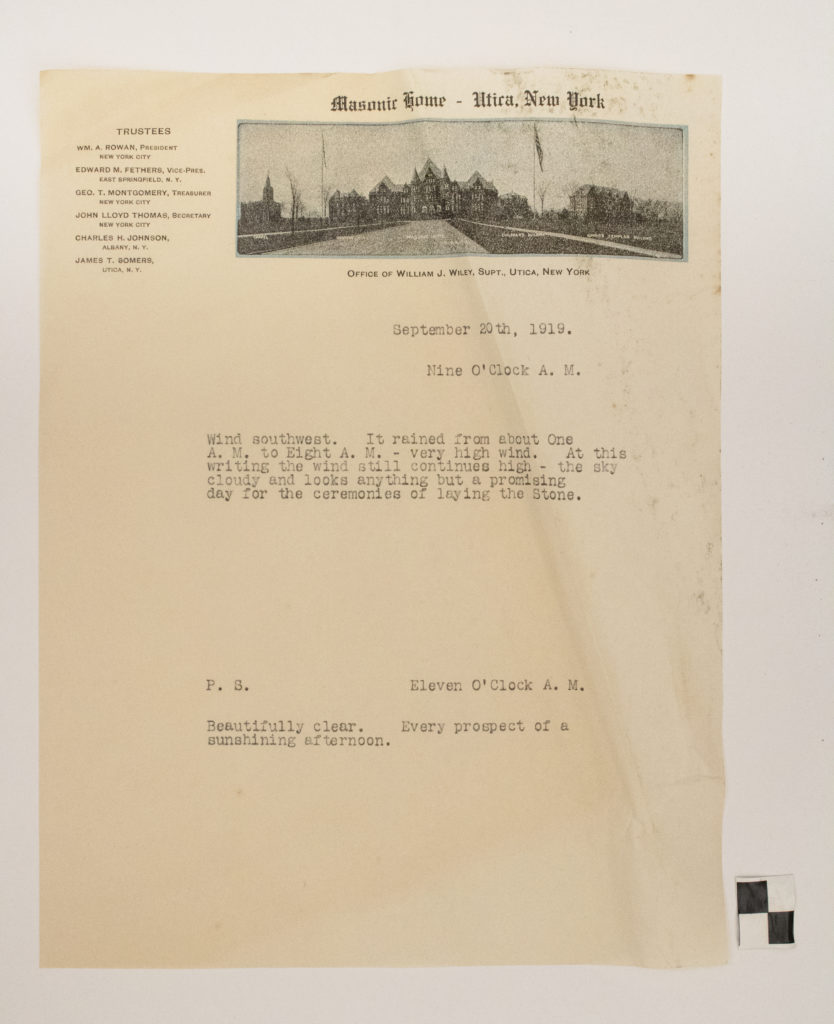
So now we have reached the bottom of box, this treasure chest of history, frozen in time from the days of Freemasonry one hundred years ago.
Sources Consulted:
*All images (unless otherwise noted) were used Courtesy of The Chancellor Robert R. Livingston Masonic Library of Grand Lodge.
One Hundred Years of Service to Humanity. Masonic Home Centennial, 1993.
Bowers, Q. David. A Guide Book of United States Type Coins: A Complete History and Price Guide for the Collector and Investor. Atlanta: Whitman Publishing, LLC, 2006.
Yeoman, R. S. Handbook of United States Coins: 2008. (65th Edition). Atlanta: Whitman Publishing, LLC, 2007.
Subject Files, Biography Files, and Masonic Home Files and the Deceased Grand Lodge Officers and Second Grand Lodge Register, 1832-1853 Card Catalogues *(All from the Chancellor Robert R. Livingston Masonic Library of Grand Lodge)
“Walter C. Montgomery.” The Hall of Valor Project. Site Accessed 12 November 2019. https://valor.militarytimes.com/hero/17958
“William McKinley: President and Freemason.” Scottish Right Masonic Museum & Library. Site Accessed 12 November, 2019. https://www.srmml.org/exhibitions/current-exhibitions/william-mckinley-president-and-
“The 46 Star Flag.” This website is dedicated to the Flag of the United States of America. Site Accessed 15 November 2019. https://www.usflag.org/history/the46starflag.html
“In Memory of Those Who Died: Formal Exercises in Connection with Laying of Cornerstone of New Soldiers’ and Sailors’ Memorial Hospital in Utica Takes Place To-Day.” Utica Saturday Globe, 20 September, 1919, Second Section, 5.
“Cornerstone Laying Here On Saturday: Big Masonic Event a Great Honor to City of Utica and Masonic Fraternity—Soldiers and Sailors’ Hospital at Masonic Home a Memorial to Men Who Gave Life and Service to Their Country. Parade Will Be Held; Grand Officers Coming.” Utica Herald-Dispatch, Thursday Evening, 18 September, 1919, 2.


